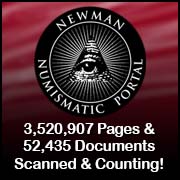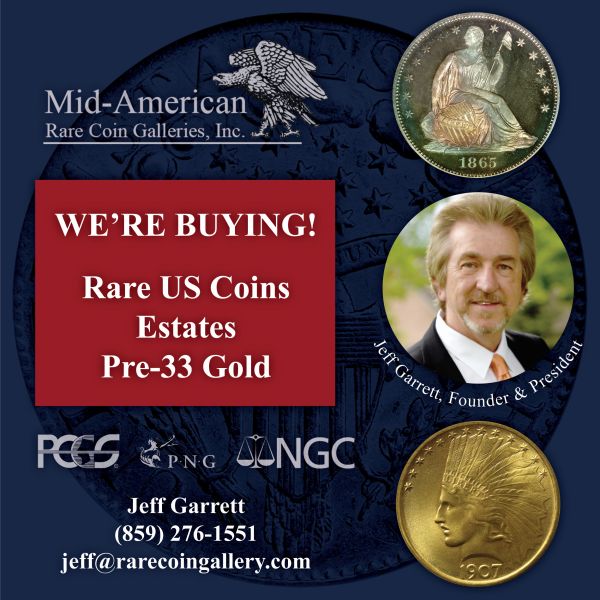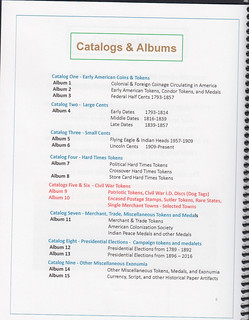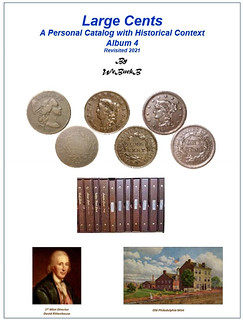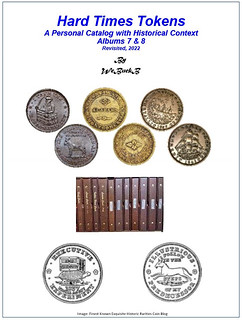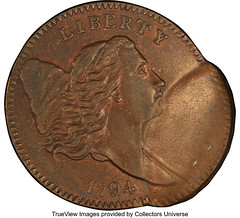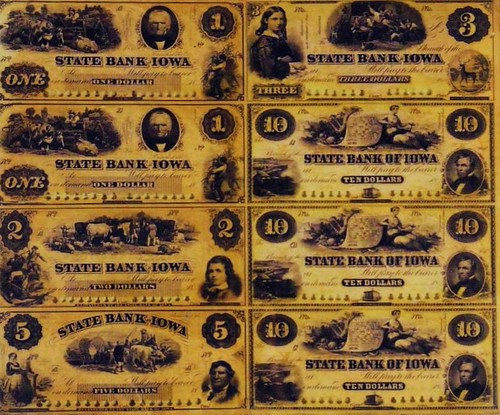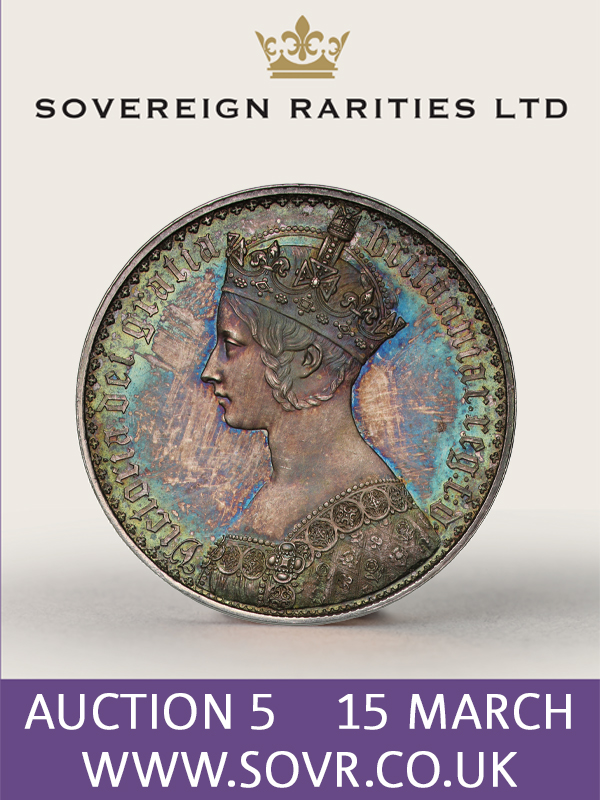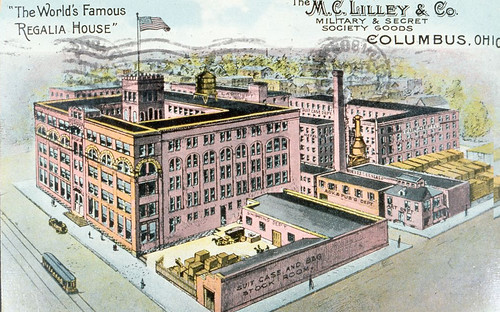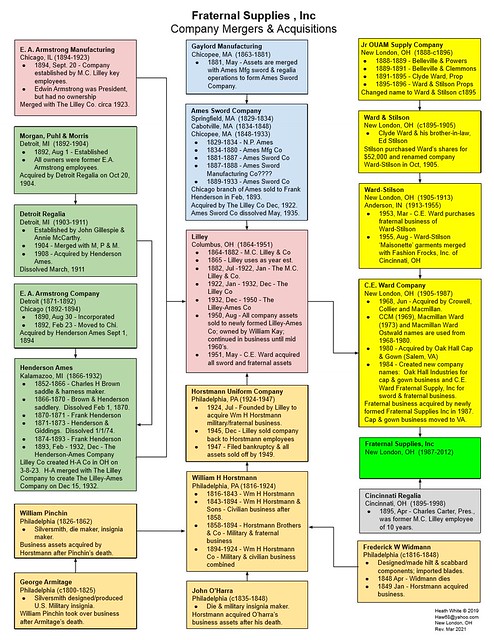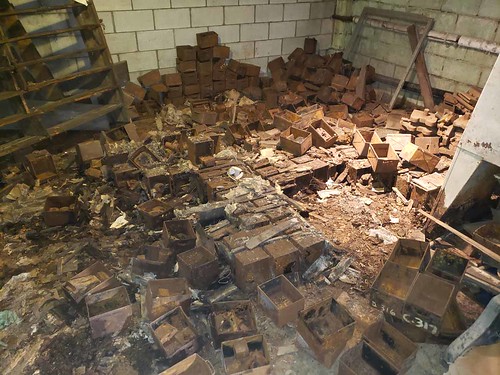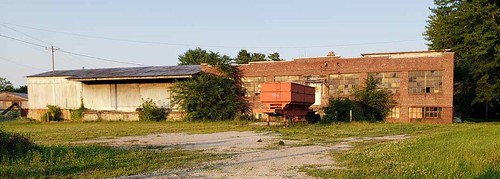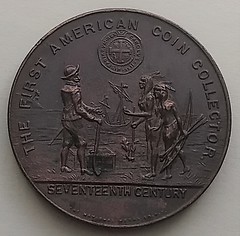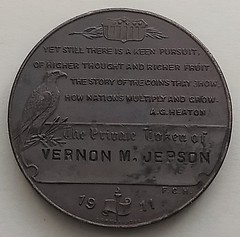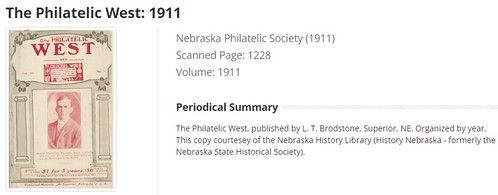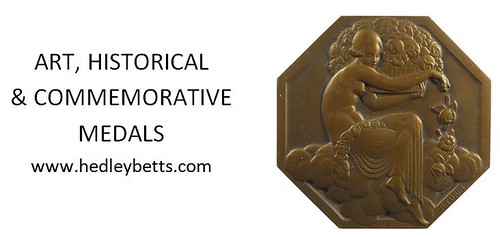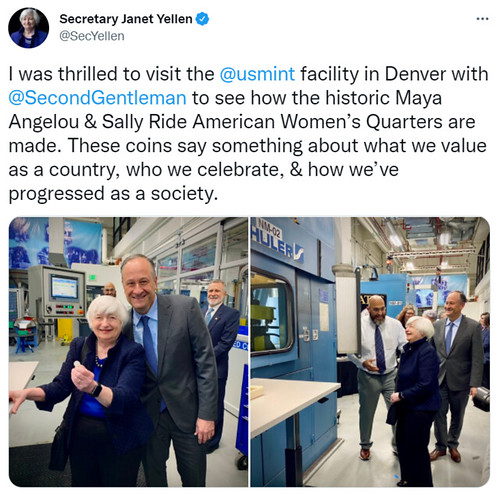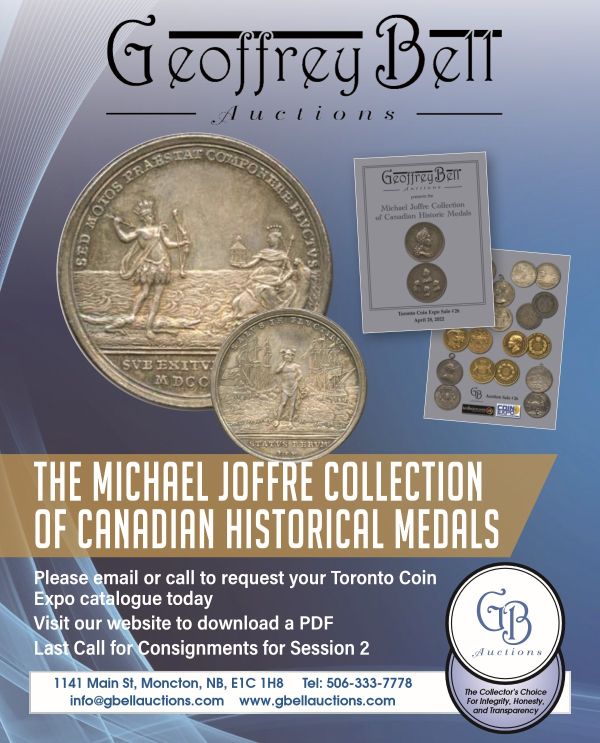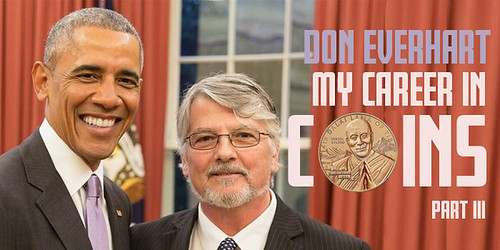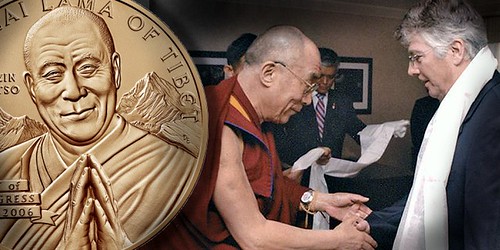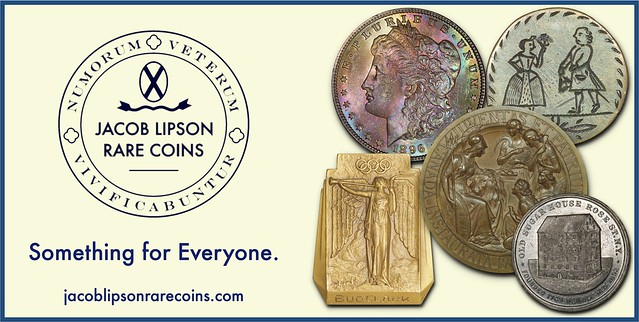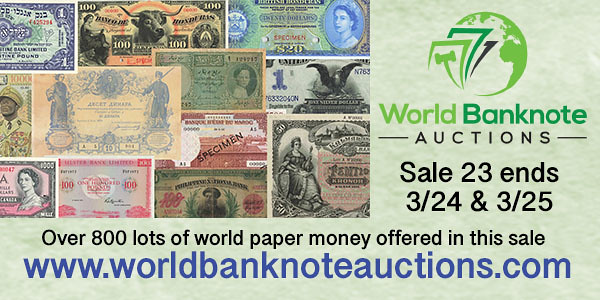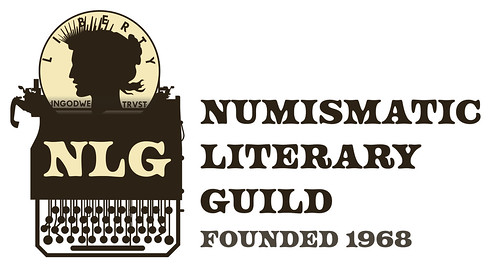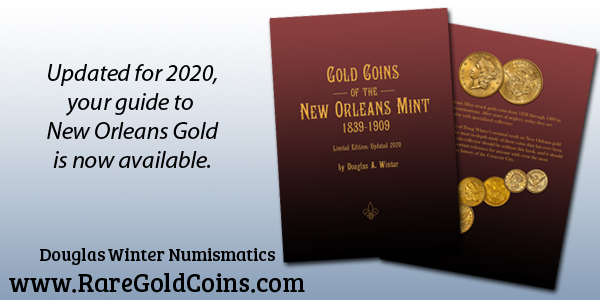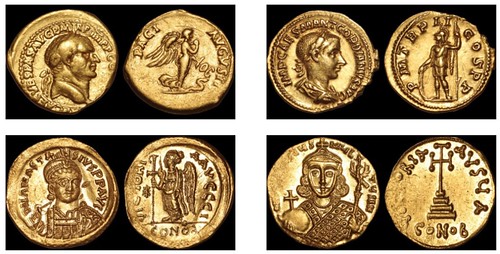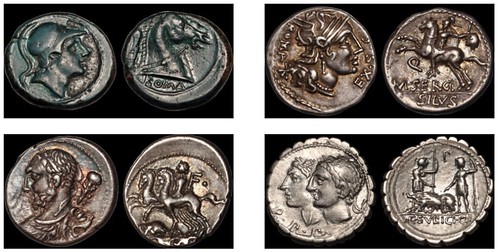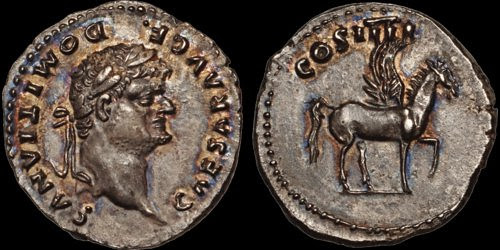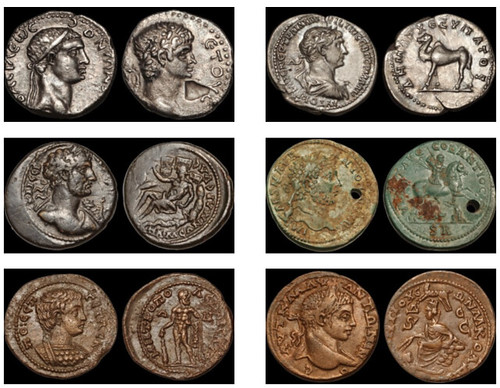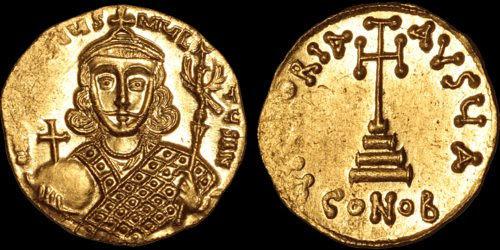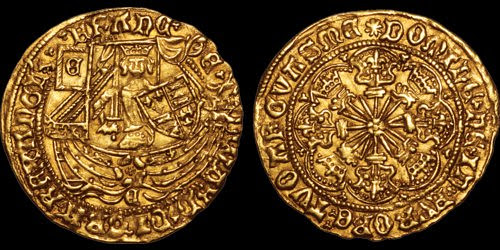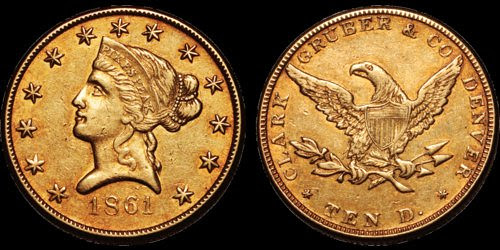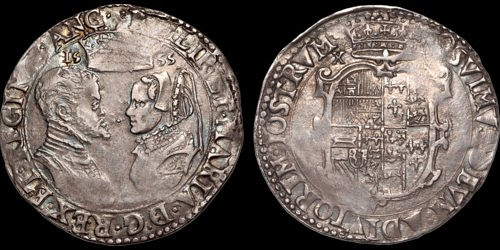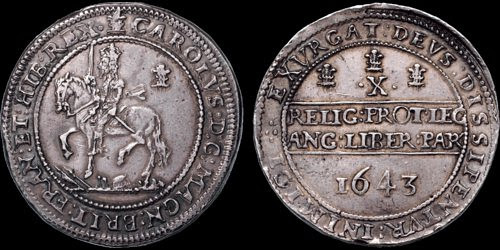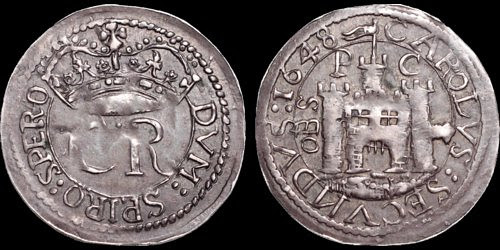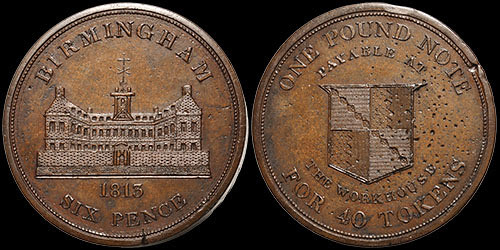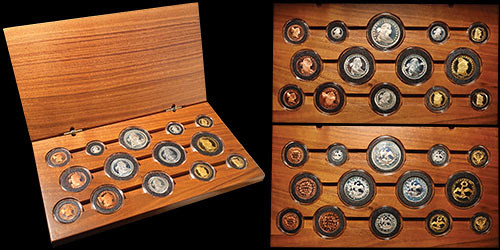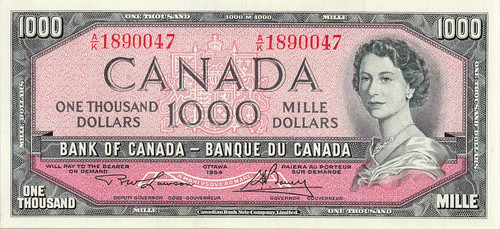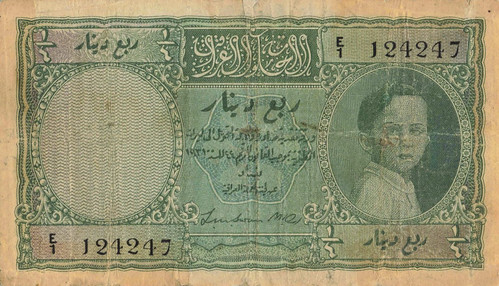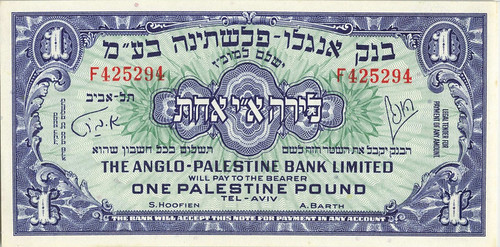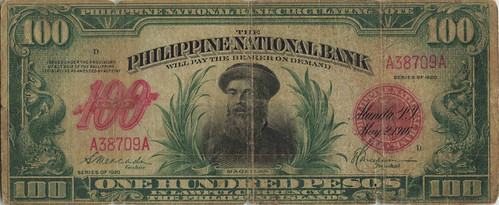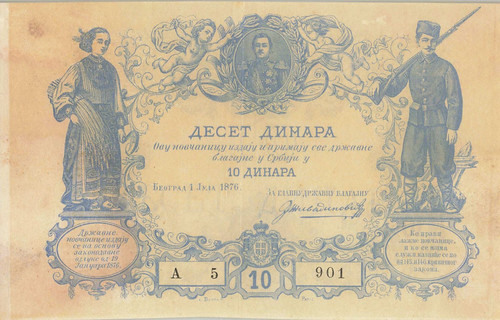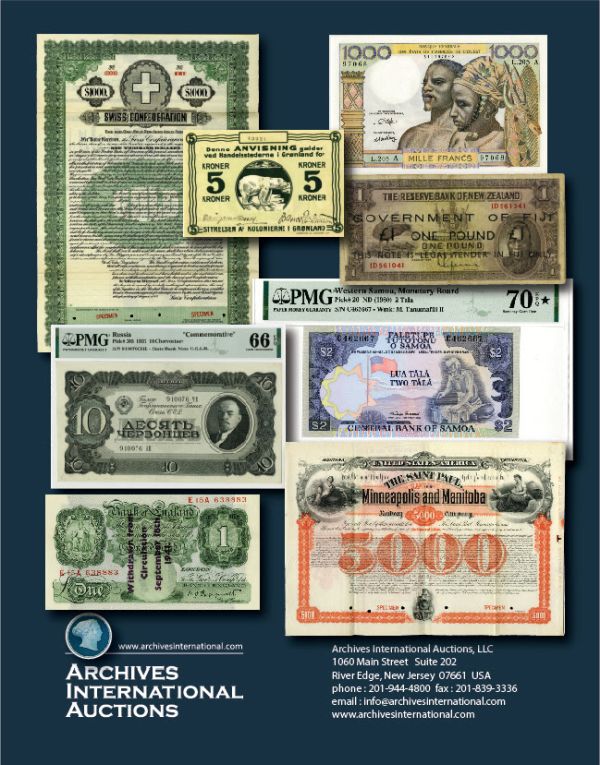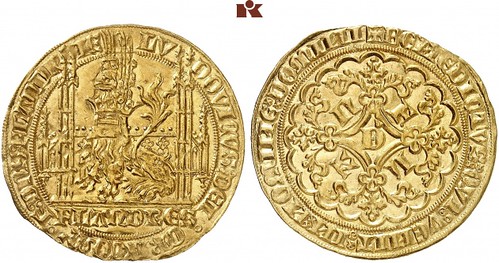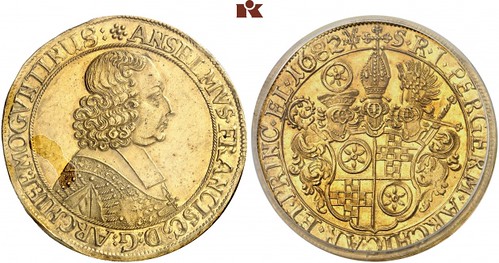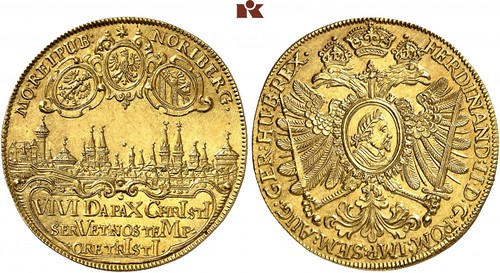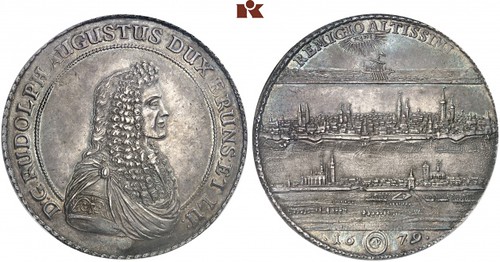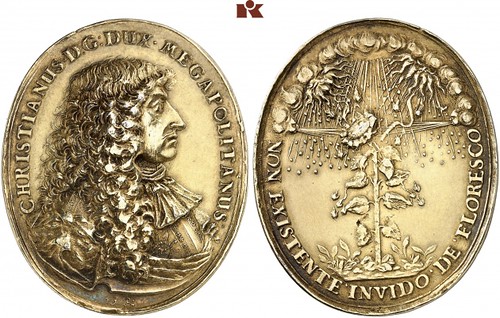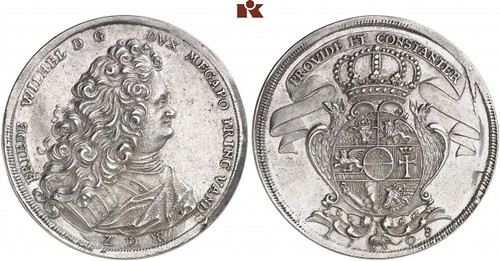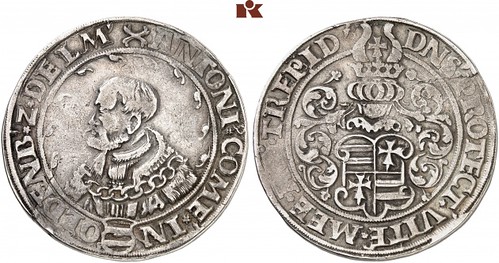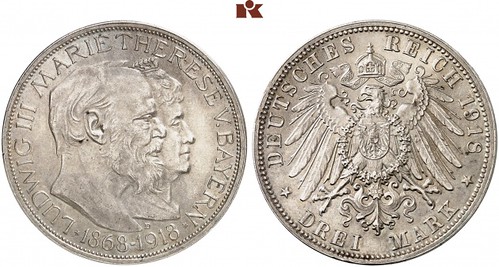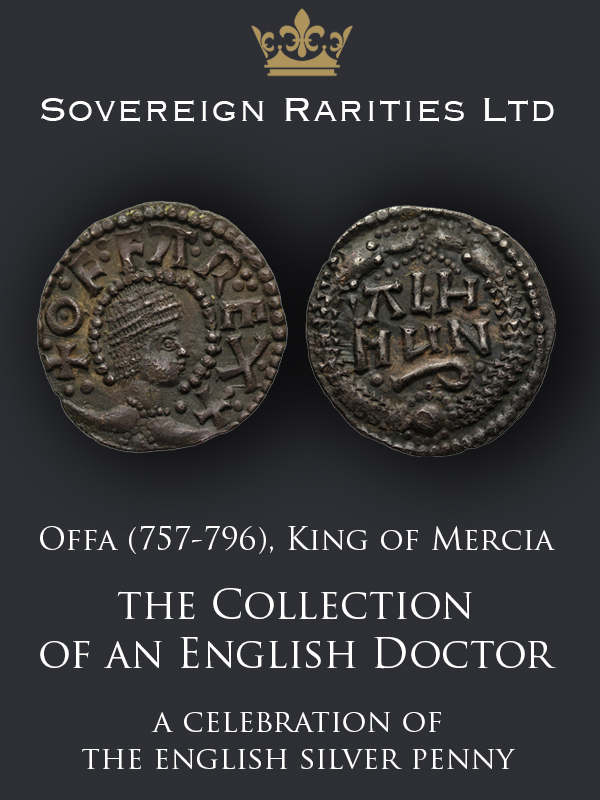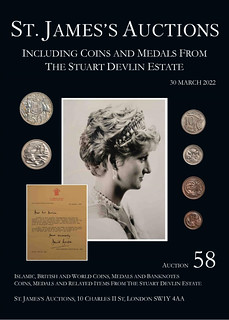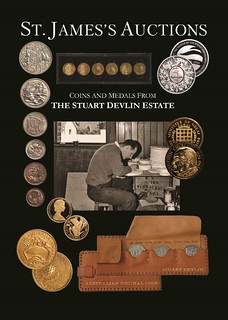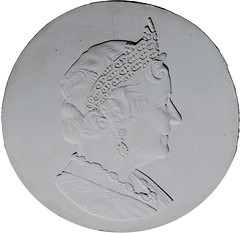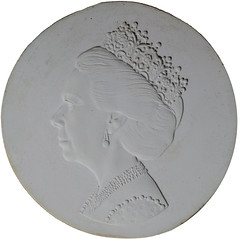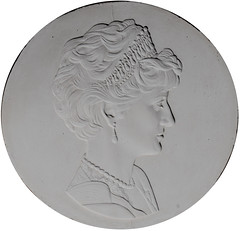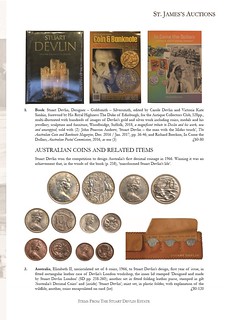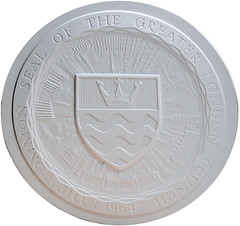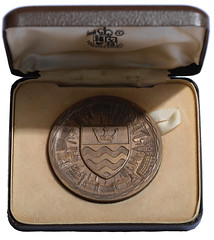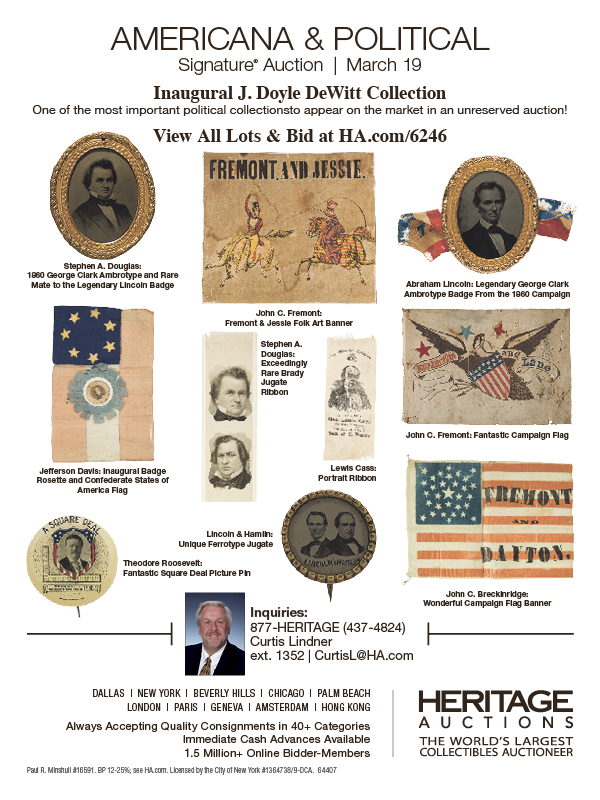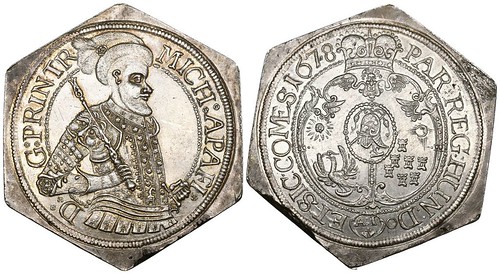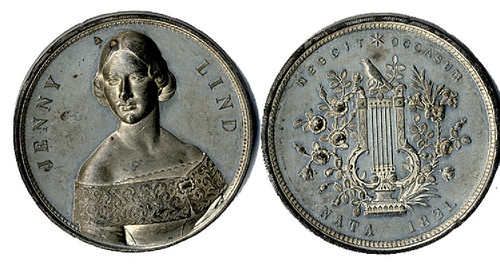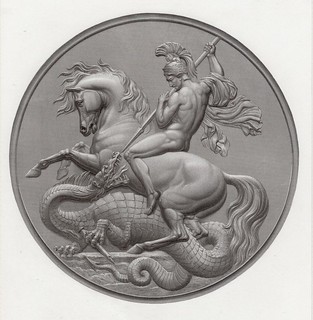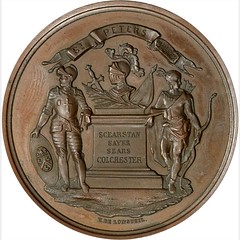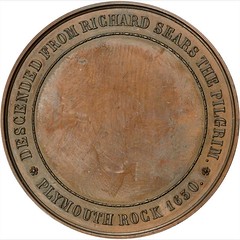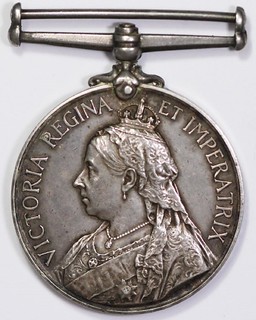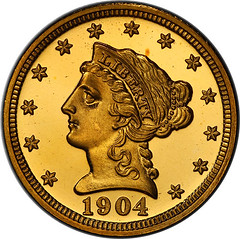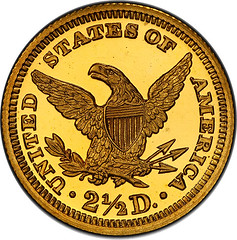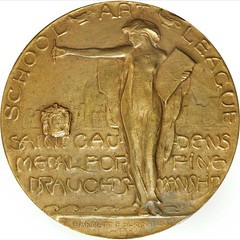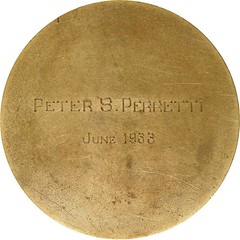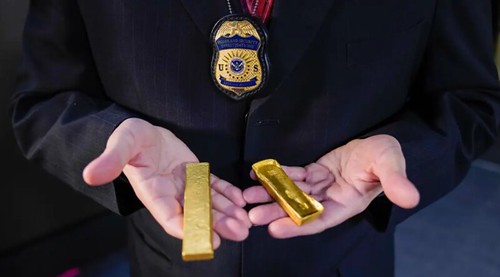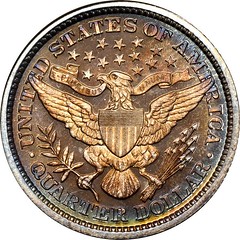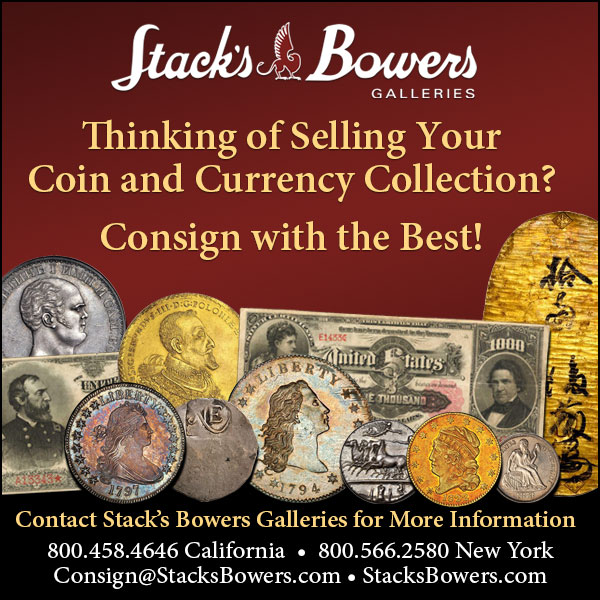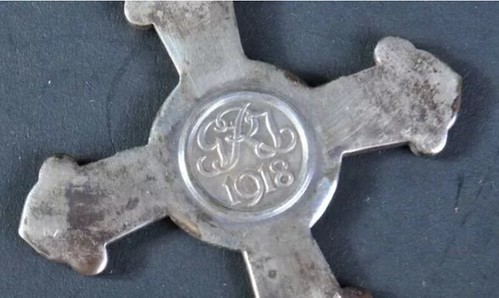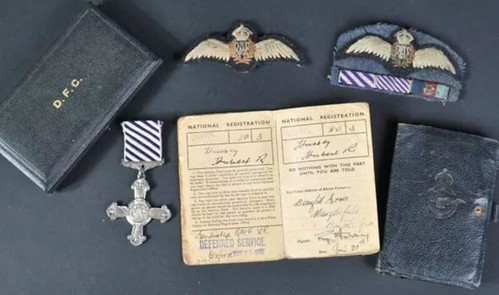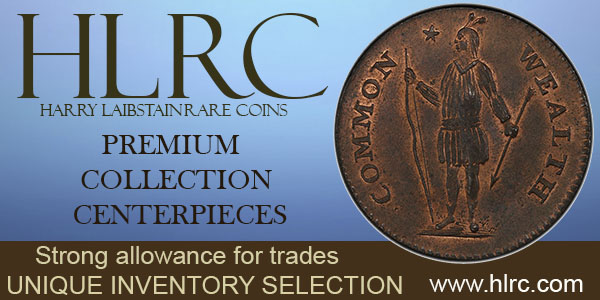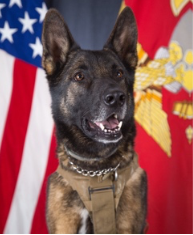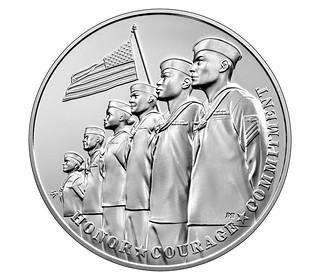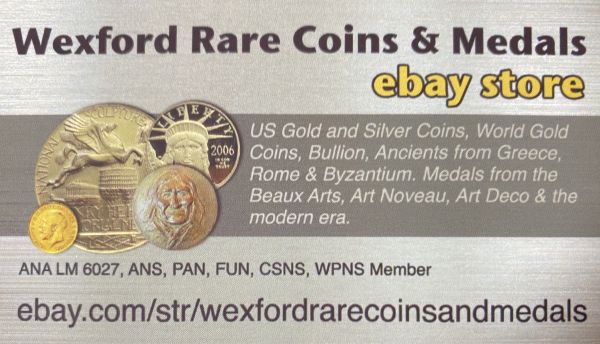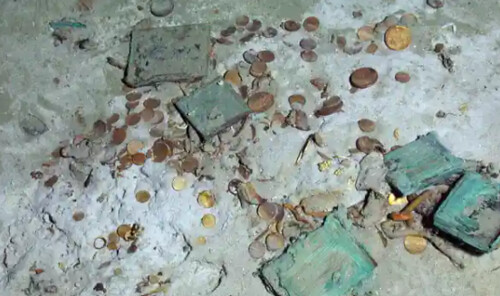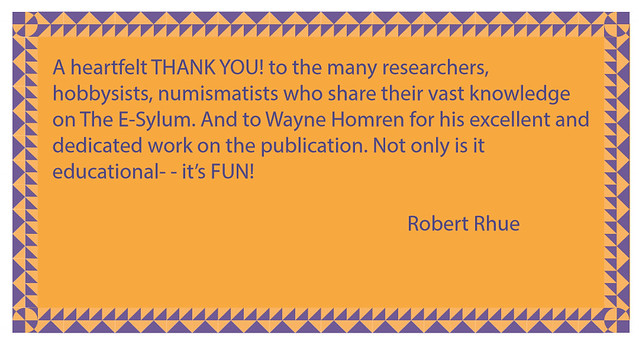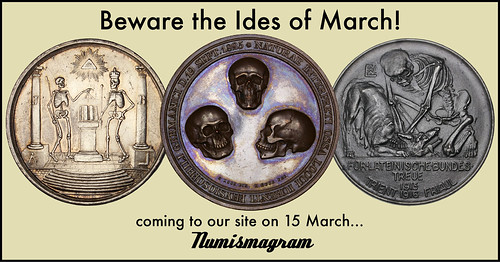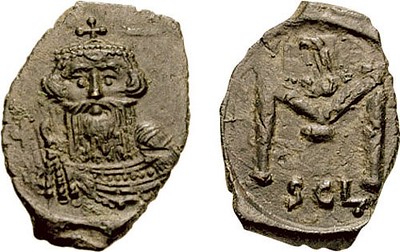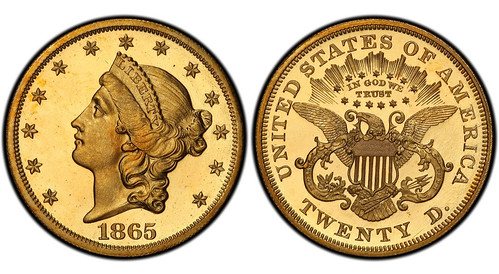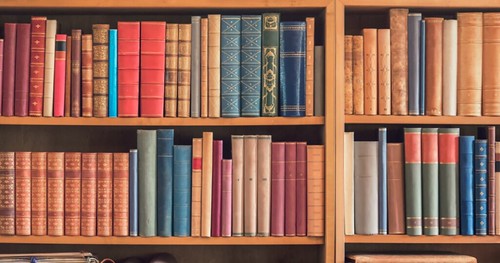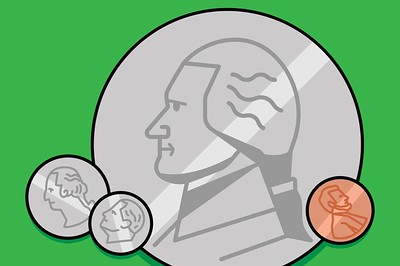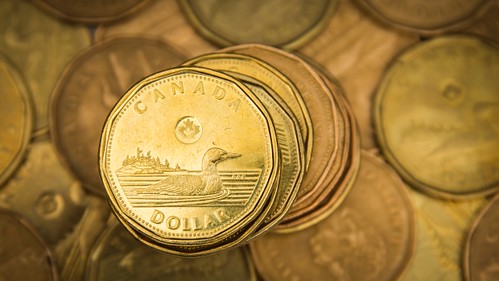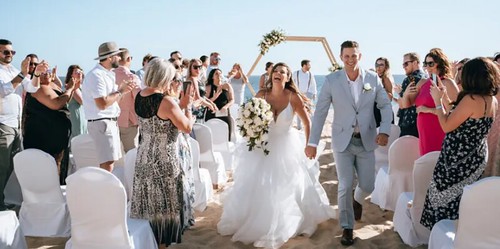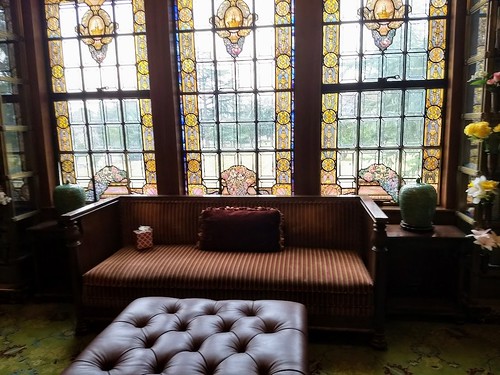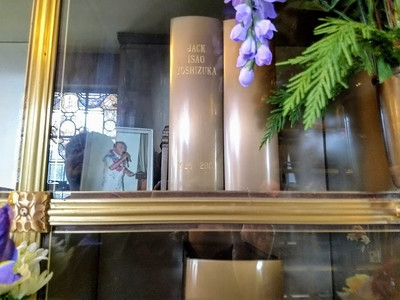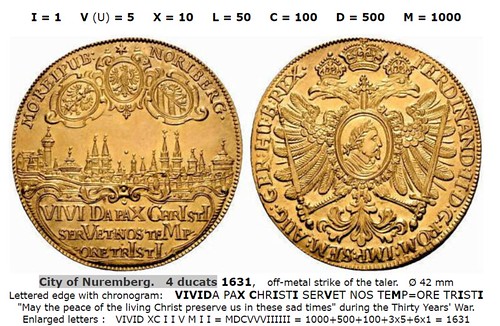
Visit our NBS Sponsors



About UsThe Numismatic Bibliomania Society is a non-profit association devoted to the study and enjoyment of numismatic literature. For more information please see our web site at coinbooks.org SubscriptionsThose wishing to become new E-Sylum subscribers (or wishing to Unsubscribe) can go to the following web page link MembershipThere is a membership application available on the web site Membership Application To join, print the application and return it with your check to the address printed on the application. Print/Digital membership is $40 to addresses in the U.S., and $60 elsewhere. A digital-only membership is available for $25. For those without web access, write to: Charles Heck, Treasurer AsylumFor Asylum mailing address changes and other membership questions, contact Chuck at this email address: treasurer@coinbooks.org SubmissionsTo submit items for publication in The E-Sylum, write to the Editor at this address: whomren@gmail.com BUY THE BOOK BEFORE THE COIN |
- WAYNE'S WORDS: THE E-SYLUM MARCH 13, 2022
- NEW BOOK: CIVIL WAR TOKENS
- JAMES R. MCGUIGAN (1944-2022)
- CIRCULATION OF THE STATE BANK OF IOWA
- VIDEO: 2002 NEW YORK ANA CONVENTION
- 1,000 YEARS OF DIE STAMPING HISTORY
- FRATERNAL SUPPLIES STAMPING DIE COLLECTION
- STILL MORE ON VERNON MARSHALL JEPSON
- NOTES FROM E-SYLUM READERS: MARCH 13, 2022
- BRITISH MUSEUM BOGGS OLD BAILEY NOTE EXHIBIT
- VOCABULARY TERM: HUBBING PRESS
- DIESINKERS ALEXANDER AND ANTHONY MORIN
- DON EVERHART'S CAREER IN COINS, PART 7
- ANA 2022 CLUB PUBLICATIONS COMPETITION
- ANA 2022 YOUNG NUMISMATIST LITERARY AWARDS
- NLG 2022 AWARD COMPETITION
- DAVISSONS AUCTION 41 ROMAN COINAGE
- DAVISSONS AUCTION 41 SELECTIONS
- WORLD BANKNOTE AUCTIONS SALE 23
- KÜNKER AUCTION 363 HIGHLIGHTS
- ST. JAMES OFFERS STUART DEVLIN ITEMS
- NUMISMATIC NUGGETS: MARCH 13, 2022
- PRINCE DE CONTY GOLD INGOTS RETURNED
- ELIASBERG PROOF QUARTER REAPPEARS
- WWII DISTINGUISHED FLYING CROSS MEDAL OFFERED
- THE CONGRESSIONAL SPACE MEDAL OF HONOR
- SECRET SERVICE DOG DISTINGUISHED SERVICE MEDAL
- UNITED STATES NAVY SILVER MEDAL
- SS CENTRAL AMERICA'S PHOTOGRAPHIC TREASURE
- CABBAGE KEY
- LOOSE CHANGE: MARCH 13, 2022
- MAN WOOS BRIDE WITH LUCKY LOONIES
- VISITING THE STRANGEST "LIBRARY" EVER
- FEATURED WEB PAGE: CHRONOGRAMS ON COINS
Click here to read the thin version on the web
Click here to subscribe
Click here to access the complete archive
To comment or submit articles, reply to whomren@gmail.com
Content presented in The E-Sylum is not necessarily researched or independently fact-checked, and views expressed do not necessarily represent those of the Numismatic Bibliomania Society.
WAYNE'S WORDS: THE E-SYLUM MARCH 13, 2022
 New subscribers this week include:
J.R. Greene, courtesy John Ferreri;
Dana Linett, courtesy Ron Guth;
Ted Minkinow, courtesy Bob Hurst;
Jeff Lewis,
and Heath White.
Welcome aboard! We now have 6,961 subscribers.
New subscribers this week include:
J.R. Greene, courtesy John Ferreri;
Dana Linett, courtesy Ron Guth;
Ted Minkinow, courtesy Bob Hurst;
Jeff Lewis,
and Heath White.
Welcome aboard! We now have 6,961 subscribers.
Thank you for reading The E-Sylum. If you enjoy it, please send me the email addresses of friends you think may enjoy it as well and I'll send them a subscription. Contact me at whomren@gmail.com anytime regarding your subscription, or questions, comments or suggestions about our content.
This week we open with five new books, an obituary, updates from the Newman Numismatic Portal, and 1,000 years of die stamping history.
Other topics this week include the State Bank of Iowa, Money Artist J.S.G. Boggs, dies and diesinkers, literary award competitions, auction previews, Numismatic Nuggets, and medals for soldiers, astronauts, service dogs and sailors.
To learn more about Civil War Tokens, half cents, the 2002 New York ANA convention, an old Ferracute coining press, Vernon Jepson, Treasury Secretary Janet Yellen, Boris Karloff, the Dalai Lama, Stuart Devlin, Jenny Lind, William Wyon, Pikes Peak gold, the siege at Pontefract, Swedish Enskilda banknotes, chronograms, why nickel is worth more than a dime, the Distinguished Flying Cross and the Congressional Space Medal of Honor, read on. Have a great week, everyone!
Wayne Homren
Editor, The E-Sylum
NEW BOOK: CIVIL WAR TOKENS
Doug Nyholm edits the UNS Mint Master for the Utah Numismatic Society. In the March 2022 issue, he mentioned a book about Civil War Tokens by dealer Buck Burgess. With permission, we're republishing his note here. Thanks! -Editor
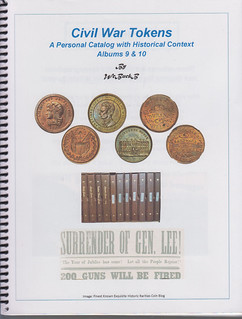 At our recent coin show I purchased a book about Civil War Tokens from Buck Burgess, who is a regular dealer at our Utah coins shows. This book is based on his personal collection and very well documented with a great deal of this personal research. There are a number of references available about Civil War Tokens including Fuld's massive
At our recent coin show I purchased a book about Civil War Tokens from Buck Burgess, who is a regular dealer at our Utah coins shows. This book is based on his personal collection and very well documented with a great deal of this personal research. There are a number of references available about Civil War Tokens including Fuld's massive US Civil War Store Cards and Patriotic Civil War Store Cards
and Patriotic Civil War Tokens
edited by Susan Trask. This book however, documents the author's personal collection and does not cover everything but I found it to be very useful and interesting for anyone desiring a basic set, or beginning to collect these historic tokens.
The author states that Civil War Tokens are divided into three categories, Patriotic Store Card, Sutler tokens, of which over 1,500 merchants had tokens made for them, and finally Patriotic tokens which were struck from over 1,500 dies. Collecting these pieces in order to assemble a complete set is therefore impossible. His collection is comprised of hundreds of different types each having a full page dedicated to it. Also included is historical notes, numismatic comments, and images including full color oversize images of the token itself.
I have included a typical page after this review. The book is priced at $25, coil bound, and consists of 170 pages. I thoroughly enjoyed the book. It is available directly from the author at Wcbuckb@aol.com , or this next time you see him at a local coin show.
I contacted Buck about shipping fees and the other books in his series. Here's his response. -Editor
Shipping is extra, so it depends on where I ship. I ship book rate so it may take 10 to 14 days unless otherwise requested.
I have five series catalogs - all at $25.00. I call them "Personal Catalogs".
- Large Cents
- Small Cents
- Political part 1 (Presidential election 1788-1896)
- Hard Times Tokens
- Civil War Tokens.
Every coin and token pictured is from my collection. Before I'm through, I (God willing) will have 9 catalogs.
To more information, or to order, contact Buck at Wcbuckb@aol.com
JAMES R. MCGUIGAN (1944-2022)
Dealer and large early copper specialist Jim McGuigan has passed. Here's an excerpt from his online obituary. Thanks to Western Pennsylvania Numismatic Society President Corleen Chesonis for passing this along. Sorry to hear the news. -Editor
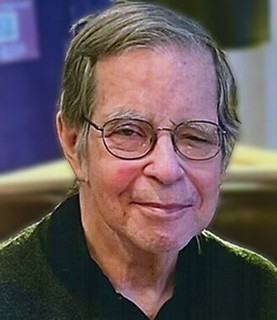 Peacefully passed on March 10, 2022, with his loving wife, Claire by his side. Jim was born in Pittsburgh to the late James and Helen McGuigan. Beloved husband of Claire A. Stitzell-McGuigan. Special dad of Theresa (Ben) Edwards. Coin Pappy of Timothy and Khloe Edwards. Dear brother of David McGuigan of Wilmington, Delaware. Jim was a graduate of Edgewood High School. He then attended Carnegie Mellon University (BS), University of Chicago (MBA), University of Pittsburgh (PhD). He was a Professor at Wayne State University School of Business. Jim was a member of St. John Fisher, Churchill, Pa.
Peacefully passed on March 10, 2022, with his loving wife, Claire by his side. Jim was born in Pittsburgh to the late James and Helen McGuigan. Beloved husband of Claire A. Stitzell-McGuigan. Special dad of Theresa (Ben) Edwards. Coin Pappy of Timothy and Khloe Edwards. Dear brother of David McGuigan of Wilmington, Delaware. Jim was a graduate of Edgewood High School. He then attended Carnegie Mellon University (BS), University of Chicago (MBA), University of Pittsburgh (PhD). He was a Professor at Wayne State University School of Business. Jim was a member of St. John Fisher, Churchill, Pa.
Among Jim's many accomplishments was traveling, co- author of two books; Contemporary Financial Management, Managerial Economics. Among all things Jim was a serious Numismatic enthusiast. He will also be missed by his dog, Sunny and many friends.
A visitation for Jim will be held on Tuesday from 7:00 until 9:00 PM at ALFIERI FUNERAL HOME INC., 201 Marguerite Ave., Wilmerding, PA. Mass of Christian Burial on Wednesday at St. John Fisher of St. Joseph the Worker Parish at 10:00 AM.
To read the complete obituary, see:
JAMES R. MCGUIGAN
(https://obituaries.post-gazette.com/obituary/james-r-mcguigan-1084629356)
I didn't know Jim well, but often stopped to chat with him at coin shows. He was a regular at the Pittsburgh-area PAN shows as well as the ANA and other national shows. In the June 2021 issue of The Numismatist, he published an article about how he became a collector and dealer. We published an excerpt in The E-Sylum - here's an excerpt of the excerpt... -Editor
As a young boy growing up in Pittsburgh, I was bitten by the collecting bug early in life. In addition to coins, I collected stamps, comic books, baseball cards and toy soldiers. I began acquiring coins when I was about 10 years old. Like many beginning collectors in this era, I started filling holes in Whitman folders with Lincoln cents my parents received in change. Later, my father brought home a few rolls of cents from the bank each week so I could look for dates I was missing. I also expanded my collection to include other denominations— nickels, dimes, quarters, half dollars and silver dollars.
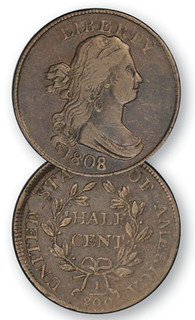 I found it difficult to locate certain dates (and mintmarks) in change, so I started visiting local coin shops. After buying a copy of A Guide Book of United States Coins (the Red Book) and learning how scarce and valuable many of the key dates were in each denomination, I started saving my allowance to purchase some of these coins. My interest in early U.S. coins was sparked in 1957 when I purchased several half cents, including the 1797 1 Above 1 and 1804 Spiked Chin varieties from Addison Smith—a Pittsburgh dealer.
I found it difficult to locate certain dates (and mintmarks) in change, so I started visiting local coin shops. After buying a copy of A Guide Book of United States Coins (the Red Book) and learning how scarce and valuable many of the key dates were in each denomination, I started saving my allowance to purchase some of these coins. My interest in early U.S. coins was sparked in 1957 when I purchased several half cents, including the 1797 1 Above 1 and 1804 Spiked Chin varieties from Addison Smith—a Pittsburgh dealer.
Since local dealers did not have many early coppers in stock, I started acquiring more pieces from auctions. One that caught my attention was the June 1970 Stack's James C. Rawls sale, which had a number of mid-grade half cents and large cents that I needed for my collection. I was a successful mail bidder on six lots, including an 1808/7 Gilbert-1 half cent (Lot 1123) for $100, graded Fine to Very Fine. I did not know the significance of this coin until I met Roger Cohen at the ANA's 1973 Boston Convention and purchased a copy of his reference American Half Cents (1971).
Bill Eckberg notes that this summer Heritage will be selling Jim's half cent collection. Here's a great error piece that caught my eye. -Editor
To view the McGuigan lots, see:
https://coins.ha.com/c/search-results.zx?N=3183+792+4294940318&type=surl-1348
To read the earlier E-Sylum article, see:
THE COIN THAT CHANGED JIM MCGUIGAN'S LIFE
(https://www.coinbooks.org/v24/esylum_v24n23a14.html)
CIRCULATION OF THE STATE BANK OF IOWA
The latest addition to the Newman Numismatic Portal is a research article on the State Bank of Iowa. Project Coordinator Len Augsburger provided the following report. -Editor
Paper Money Research Sponsored by Eric P. Newman Numismatic Education Society
Recently published by Dr. James Ehrhardt, Circulation of the State Bank of Iowa
investigates paper money issued under the State Bank of Iowa system in the 1850s and 1860s. The state authorized 15 branches, and Ehrhardt explores the various currency issues produced by these individual branch banks, which operated under the governance of the State Bank. With a redemption rate approaching 100%, few examples survive, and Ehrhardt has produced a census of 72 examples. Ehrhardt cast a wide net, exploring archival bank ledgers, private collections, and related items in the State Historical Society of Iowa.
This article is available on Newman Portal, and also appeared in the March-April 2022 edition of Paper Money, the journal of the Society of Paper Money Collectors. Ehrhardt's research was sponsored in part by a Newman Grant from the Eric P. Newman Numismatic Education Society (EPNNES). Applications for Newman Grants for 2022 are now being accepted, through April 15, with awards to be announced on May 25, coincident with Eric P. Newman's birthday.
Image: Uncut currency sheet issued under the State Bank of Iowa system, from the State Historical Society of Iowa
Link to Circulation of the State Bank of Iowa
on Newman Portal:
https://nnp.wustl.edu/library/publisherdetail/521016?Year=2022
Link to 2022 Newman Grant Application:
https://nnp.wustl.edu/library/archivedetail/530553?Year=2022&take=50
VIDEO: 2002 NEW YORK ANA CONVENTION
These are selections from the David Lisot Video Library that feature news and personalities from the world of coin collecting. David has been attending coin conventions since 1972 and began videotaping in 1985. The Newman Numismatic Portal now lists all David's videos on their website at:
https://nnp.wustl.edu/library/multimediadetail/522852
Here's one on the 2002 New York ANA convention. -Editor
ANA Convention Highlights New York, 2002 July
VIDEO: 32:03
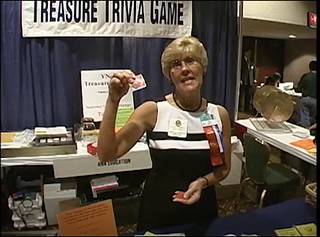 Get ready for a blast from the past! This video is from from the American Numismatic Association World's Fair of Money held in New York 20 years ago. Ed Rochette was ANA Executive Director, John Wilson, president, Gail Baker, Education Director, Henrietta Holsman Fore, US Mint Director, as well as
other characters. Plus you will see shots of the bourse floor and people with more vigor and heads of hair then they now have. One of the best parts of numismatics is the memories and if you are old enough in the hobby this video is sure to provoke them.
Get ready for a blast from the past! This video is from from the American Numismatic Association World's Fair of Money held in New York 20 years ago. Ed Rochette was ANA Executive Director, John Wilson, president, Gail Baker, Education Director, Henrietta Holsman Fore, US Mint Director, as well as
other characters. Plus you will see shots of the bourse floor and people with more vigor and heads of hair then they now have. One of the best parts of numismatics is the memories and if you are old enough in the hobby this video is sure to provoke them.
David adds:
"I am just back from the ANA Convention in Colorado Springs where I shot new video that will be posted soon. How times have changed! The numismatic characters are different but the core basics of the hobby remain the same; buying and selling, knowledge, and camaraderie. Those of us who have been in numismatics for the long term will know of what I speak."
To watch the video:
https://nnp.wustl.edu/library/book/578800
1,000 YEARS OF DIE STAMPING HISTORY
In our February 20th issue, Carol Bastable mentioned discovering an eBay seller with "a glut of Masonic penny dies as well as all sorts of dies and stamps for various fraternal organizations, military, medals, advertising, and jewelry making items."
The seller mentioned that one die was "From the archives of MC Lilley". I published some information on the company and asked, "Is anyone aware of the location of their archives? Clearly the old dies and stock have been sold off, but do company records survive in some University or historical society holdings?"
Carol followed up with the eBay seller, who put us in touch with Heath White, from whom he had purchased the material. Thanks! Heath liquidated the stock of an Ohio company called Fraternal Supplies, a successor to M C Lilley and a number of similar firms. Heath kindly provided background information and photos seen here in two articles. Thank you! -Editor
My stepfather, Thom Mezick, owned a small company here in New London, OH called Fraternal Supplies. Fraternal Supplies ceased operations in 2012 and Thom passed away in 2016. Thom acquired the company in 1987 in an attempt to prevent one more manufacturer from closing their doors in our community. Thom hired others to manage the company and it lost money every year he owned it. Before Thom passed away I had never been in the factory and he rarely spoke about it due to his disappointment in the lack of success of the company.
When I first entered the factory building, what I saw was a building with multiple leaks in the roof, windows broken out, and many areas of the floor not even safe to walk on for fear of falling through the floor. The company artifacts stored in the building were all either rotting, rusting, or covered in mold and nothing was organized. I knew there were items that were supposedly historically significant, but couldn't tell someone what a fraternal organization was, didn't know anything about swords or military goods, and stamping dies, die sinkers, and numismatics were not terms ever used in my vocabulary. I walked in the building knowing nothing other than I was the one responsible for dealing with the mess.
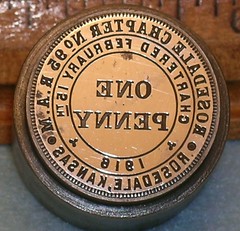 After reaching out to auction houses (national and local), auctioneers, museums (national and local), other manufacturers of similar items, and appraisal firms, every one of them told me what I had was of no value and I was wasting my time. The county was threatening to put the building up for sheriff sale so I had the choice of walking away or doing something very quickly. I spent a few months organizing items and sold the majority of the "worthless" items in the building in wholesale lots to three dealers, raising a substantial sum in return for my time. I did my best to preserve company records and history and keep most of the better artifacts for my collection.
After reaching out to auction houses (national and local), auctioneers, museums (national and local), other manufacturers of similar items, and appraisal firms, every one of them told me what I had was of no value and I was wasting my time. The county was threatening to put the building up for sheriff sale so I had the choice of walking away or doing something very quickly. I spent a few months organizing items and sold the majority of the "worthless" items in the building in wholesale lots to three dealers, raising a substantial sum in return for my time. I did my best to preserve company records and history and keep most of the better artifacts for my collection.
Knowing nothing about the company history, I purchased several books pertaining to sword manufacturers because among other things the companies involved here were the largest, most prestigious, and most prolific manufacturers of swords in American history. As someone that was admittedly ignorant I remember reading the first book thinking much of the information in the book about sword manufacturers was simply not true. Thus began my quest to do my own research. I've spent the past few years researching company history, history of the artifacts in the factory, preserving the artifacts I kept, and acquiring back many pieces that were initially sold.
Turns out that little ole Fraternal Supplies was the successor company to over 20 other manufacturers. These companies were in business for nearly 1,000 years cumulatively, employed many thousands of employees, and produced millions of items. All the companies involved produced items for fraternal organizations and most manufactured military, police, and fire related goods too. Here is a flowchart that shows most of the companies involved (I ran out of room to add more) and how they became part of Fraternal Supplies. Nine of these companies produced goods using stamping dies.
My collection consists mostly of company research and history, stamping dies, casting patterns, trade catalogs, original company artwork, and printing blocks. I like to say I collect the things that made the things other people collect. I own exactly one sword, one medal, and one Civil War token. Last year I acquired two other collections of stamping dies and am in the process of cleaning, documenting, and preserving them. My plan is to keep all company history information and the best examples of dies from the collections and the rest will go to the eBay seller you got my contact information from, AuctionPlanner.
As a final note, one of the things I have been unable to salvage from the factory building is an old Ferracute coining press. It was set up in the basement of the building then the building was added on to in later years making the removal of the press more involved and costly than the press is probably worth.
But what a centerpiece for a numismatic museum! Thank you for this background. Bless you! It is a relief to know that much of the history is being preserved. Heath welcomes feedback, comments, and questions from readers - his address is haw68@yahoo.com . -Editor
Carol Bastable adds:
"I had no idea when I found the items on eBay that this would turn out to be such an interesting story with so much history uncovered...or perhaps, recovered.
"I do hope that we can find someone to help extract the coin press from the building, preserve it, and perhaps put it to good use again."
To read the earlier E-Sylum articles, see:
M. C. LILLEY & COMPANY
(https://www.coinbooks.org/v25/esylum_v25n08a10.html)
NOTES FROM E-SYLUM READERS: FEBRUARY 27, 2022 : More on M.C. Lilley & Co.
(https://www.coinbooks.org/v25/esylum_v25n09a16.html)
THE BOOK BAZARRE
FRATERNAL SUPPLIES STAMPING DIE COLLECTION
Heath White added this article with more background on the stamping dies from the Fraternal Supplies vault. See the previous article in this issue for more information on the company lineage.
The first image is of boxes of Masonic Penny dies. The final image shows a die before and after cleaning. -Editor
 The majority of the Stamping Die Collection was
originally acquired by the C.E. Ward Company (New
London, OH) from The Lilley-Ames Company
(Columbus, OH) in 1951. The dies have been stored in
what was known as 'the vault' of the C E Ward metal
plant in New London, OH . While not really a vault, it
was a room in the basement level of a building with
cement block walls and a heavy metal door that was
normally closed and locked much like a vault. Because
of this the company employees affectionately called
this room 'the vault'.
The majority of the Stamping Die Collection was
originally acquired by the C.E. Ward Company (New
London, OH) from The Lilley-Ames Company
(Columbus, OH) in 1951. The dies have been stored in
what was known as 'the vault' of the C E Ward metal
plant in New London, OH . While not really a vault, it
was a room in the basement level of a building with
cement block walls and a heavy metal door that was
normally closed and locked much like a vault. Because
of this the company employees affectionately called
this room 'the vault'.
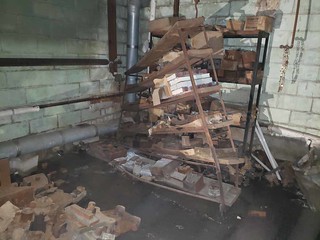 The dies were moved from Lilley-Ames in Columbus,
OH in 1951 and most hadn't been touched again until
2019. The Vault was a damp, dark room that had
standing water on the floor every time it rained. The
dies were stored in metal bins that were mostly stacked
on wooden shelves (a few were stored on metal
shelves). Over the years the bottom of the wooden
shelves rotted and legs of the metal shelves rusted.
Many of the shelves with tons (literally) of metal dies
stacked on them toppled over like dominos. In 2019 I
asked a former manager of the company why the dies
were never picked up off the floor and his response
was, 'they were like that when I started working there
20 years ago.'
The dies were moved from Lilley-Ames in Columbus,
OH in 1951 and most hadn't been touched again until
2019. The Vault was a damp, dark room that had
standing water on the floor every time it rained. The
dies were stored in metal bins that were mostly stacked
on wooden shelves (a few were stored on metal
shelves). Over the years the bottom of the wooden
shelves rotted and legs of the metal shelves rusted.
Many of the shelves with tons (literally) of metal dies
stacked on them toppled over like dominos. In 2019 I
asked a former manager of the company why the dies
were never picked up off the floor and his response
was, 'they were like that when I started working there
20 years ago.'
Gathering the dies was much like an archaeological dig, trying to pick out the dies from the jumbled up mess of rotting wood shards and rusty metal bins. Most of the dies had a cosmoline-like substance on the face of the die which protected them from rusting. In total, I estimate there were over 10,000 dies, hubs, & trimming tools in the collection. Most of them were sold to three dealers in November & December, 2019.
The subject matter on most of the dies is Military, Police Department, Fire Department or Fraternal Organizations. Political, universities, events (i.e. Wright Brothers Celebration [1909] and Jamestown Ter-Centennial [1907]) and many other topics are represented in smaller quantities.
Many dies were also found in random places spread throughout the factory. When I asked a former manager of the company why these were all over the building his response was that the dies 'made great paper weights' and were used as such.
In May, 1951, the C E Ward Company purchased most of the assets of what had become The Lilley-Ames Company in Columbus, OH. Lilley-Ames (1932-1951) was the successor company name of M. C. Lilley & Company (1864-1882), The M. C. Lilley & Company (1882-1921), and The Lilley Company (1922-1932). Before being sold to C.E. Ward, Lilley had acquired the assets of the many companies including the following:
* Henderson-Ames - Kalamazoo, MI - 1866-1932 * Wm H Horstmann - Philadelphia, PA - 1816-1947 (Fraternal and military assets of Horstmann were acquired by Lilley in 1924 and operated as Horstmann Uniform Company from 1924-1947) * Ames Sword Co - Chicopee, MA - 1829-1922 * E A Armstrong Company - Detroit 1871-1892 & Chicago - 1892-1894 * E A Armstrong Mfg Company - Chicago - 1894-1923 * Detroit Regalia – Detroit, MI – 1903-1911 * Morgan, Puhl & Morris Company - Detroit, MI - 1892-1904
The C E Ward Company was sold in 1968 to the conglomerate of Crowell, Collier and Macmillan. In 1980 Oak Hall Cap & Gown Company from Salem, VA purchased the company and split it into two operations in 1984: Oak Hall Industries (for cap & gown business) and C E Ward Fraternal Supply, Inc. (for fraternal, military, & other business assets). The cap & gown business was moved to Salem,VA in the mid 1980's and in 1987 C E Ward Fraternal Supply, Inc assets were sold and operated as Fraternal Supplies, Inc.
Fraternal Supplies continued in business until around 2012 and the sole owner of the business when it closed was Thom Mezick. Thom died in 2016. After the company ceased operations in 2012 until 2019 all company assets sat idle in a 100 year old factory building that was quickly deteriorating with windows getting broken out and new leaks developing in the roof on a regular basis.
The largest collection of dies are from The M. C. Lilley & Co and date from between 1885-1935. There are also many dies I can prove are from each of the following companies: The William H Horstmann & Sons Company, The Henderson-Ames Company, The E.A. Armstrong Company, The E. A. Armstrong Mfg Company, and The C.E. Ward Company.
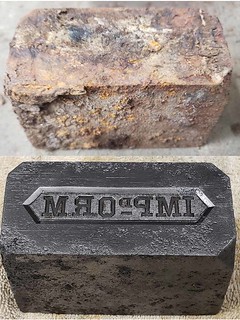 The oldest documented dies were used to make
military insignia before the Civil War by Horstmann.
Several of the earlier dies are stamped with the name
of the die maker (blacksmith) that forged the block of
steel or the diesinker (engraver) that carved the design
in the die. Some of the engravers are well-known and
have had much information written about them and
others very little is known. Some of the best known
engravers (die sinkers) represented in the collection
include Frederick C Key & Sons (Phila.), Anthony C
Paquet (Phila.), Peter H Jacobus (Phila.) , Frederick
Smith (NYC), & Gustav Horst (NYC). I have done
extensive research on and have much information on
the different die makers and die sinkers represented in
the collection.
The oldest documented dies were used to make
military insignia before the Civil War by Horstmann.
Several of the earlier dies are stamped with the name
of the die maker (blacksmith) that forged the block of
steel or the diesinker (engraver) that carved the design
in the die. Some of the engravers are well-known and
have had much information written about them and
others very little is known. Some of the best known
engravers (die sinkers) represented in the collection
include Frederick C Key & Sons (Phila.), Anthony C
Paquet (Phila.), Peter H Jacobus (Phila.) , Frederick
Smith (NYC), & Gustav Horst (NYC). I have done
extensive research on and have much information on
the different die makers and die sinkers represented in
the collection.
I attempted to keep or acquire most of the 'better' dies and after cleaning the dies, plan to photograph, organize, and document them as well as possible.
To read the earlier E-Sylum articles, see:
M. C. LILLEY & COMPANY
(https://www.coinbooks.org/v25/esylum_v25n08a10.html)
NOTES FROM E-SYLUM READERS: FEBRUARY 27, 2022 : More on M.C. Lilley & Co.
(https://www.coinbooks.org/v25/esylum_v25n09a16.html)
STILL MORE ON VERNON MARSHALL JEPSON
David Vagi submitted these additional biographical notes on Vernon Jepson. Thank you! -Editor
The information in the two previous issues of The E-Sylum was both useful and interesting, offering a peek into the collector's mind of Vernon Jepson. I have some to add.
But before we get there, I can report the number impressed on the edge of the medal issued to Jepson is 121 – so, at least that many were issued in copper.
On the Newman Numismatic Portal I got only one hit
for a Jepson with a first name beginning with a V
– an endorsement published at the bottom of page 1228 in the December, 1911 edition of The Philatelic West. It's reproduced here:
His testimonial reads: V. Jepson, Mass.: Am collector over 68 years old and have been at it ever since I can remember and think WEST the best paper for collectors.
Fortunately, it all seems to add up – this glowing testimonial must have been written by our own Vernon Jepson. His medal is dated 1911 and so is his testimonial. For some reason his interest in sharing his love of collecting peaked in 1911.
The testimonial assures Vernon's link to Massachusetts in 1911, his birth in about 1843, and earmarks his enthusiastic, lifelong attachment to collecting. A document I found dated June 7, 1911 places Vernon in Lexington, MA to witness the second marriage of his widowed daughter Nellie Alberta Lyon Jepson. Thus, Vernon was present in Massachusetts in 1911 when he wrote his magazine testimonial.
In two documents I found, Vernon's middle name is given as Marshall – his birth record and the aforementioned marriage record. So, we may assign to him the full name Vernon Marshall Jepson.
Though The Philatelic West is primarily devoted to stamps, it has ample material about other kinds of collectibles, such as coins, fossils, Indian artifacts, etc. – something a collector of varied interests would have enjoyed. Indeed, it states on the cover of this monthly magazine: The Largest and Oldest American – Collector's Magazine. Est. in 1895. Devoted to All Hobbies
. But we know from the wonderful article that shows how Mr. Jepson had covered his wall with stamps that he was a devoted philatelist, making it easy to believe he would have heaped praise upon a philatelic publication.
Now, back to Mr. Jepson's identification. His Massachusetts connection and his birthdate of c.1843 matches perfectly with the Massachusetts civil war soldier Vernon M. Jepson. Indeed, it's the only possible match that turns up. Even his middle initial M
occurs on both his medal and his Civil War records.
Below is his biography from the 1917 work, A History & Genealogy of the Descendents of John Jepson of England and Boston, Mass Through His Son John's Two Sons William and Micah, 1610-1917.
Based on the work above and several other documents, I've assembled a biography:
A self-professed, lifelong collector, Vernon Marshall Jepson was born Dec.22, 1843 in Ware, MA to parents Thomas Jepson (b.1807 in Pownal, VT, d.1886 in North Dakota) and Betsey Houghton Jepson (b.1809 in Pownal, VT, d.1897 in Webster, MA). He lived primarily in Webster, MA until his later years.
As an 18-year-old high school student and farmer in Webster, MA, Vernon enlisted in Company G of the 51st Massachusetts infantry on Aug. 25, 1862. He saw action at Kinston, White Hall and Goldsboro before, on June 10, 1863, he transferred at New Berne, NC to Company A of the 2nd Massachusetts heavy artillery. From that regiment he was allowed a quick furlough to marry his first wife, Martha Chapman (1843-1907) in Westford, CT on the 4th of July, 1863 (during which time their first child was conceived). A few days after his wedding, Vernon helped quell the draft riot in Boston before returning to duty with his regiment in North Carolina. He remained with the 51st until he mustered out at the rank of Corporal on Sept. 3, 1865 in Wilmington, North Carolina.
His military record:
After the war, Vernon took up work as a carpenter, and eventually a florist. He and Martha had three further children, a daughter Nellie and two sons, Ulysses S. Grant and Elmer V. – both of whom died before reaching age ten. Later in life he was married a second time, in 1914, to Anna T. Benton.
In addition to being a voracious collector, Vernon was a patriot in the extreme. He signed up as a teenager to serve his country in the Civil War, was married on the 4th of July and he named his first son Ulysses S. Grant! Finally, in 1917, at age 73, he informed officials in Connecticut he was available to serve his nation in WW I.
Though a Massachusetts resident most of his life, in later years he moved around, including to Connecticut and New Jersey before retiring in Florida. The 1930 federal census records that Vernon was a widower and Civil War veteran living in a house he owned at 608 (not 606) Wyoming Ave. in St. Cloud, FL with Ms. Sarah Burlingame, a 34-year-old widow from Connecticut listed as a servant.
 His house was built in 1910. Currently it is 3 bedrooms, one bath and 1,239 square feet. Since the original house still exists, one wonders if Vernon's massive wall of stamps still remains, even if under a layer of paint or wallpaper? A picture of the house in its current state is shown:
His house was built in 1910. Currently it is 3 bedrooms, one bath and 1,239 square feet. Since the original house still exists, one wonders if Vernon's massive wall of stamps still remains, even if under a layer of paint or wallpaper? A picture of the house in its current state is shown:
All told, Vernon Marshall Jepson must have been considered an eccentric old man during his final years in St. Cloud. He died in Osceola County, FL on March 10 or 12, 1932.
Thanks again - an interesting life! -Editor
To read the earlier E-Sylum articles, see:
NOTES FROM E-SYLUM READERS: FEBRUARY 27, 2022 : More on the First American Coin Collector Medal
(https://www.coinbooks.org/v25/esylum_v25n09a16.html)
MORE ON VERNON M. JEPSON
(https://www.coinbooks.org/v25/esylum_v25n10a11.html)
NOTES FROM E-SYLUM READERS: MARCH 13, 2022
Treasury Secretary Yellen Visits Denver Mint
Dick Grinolds passed along this tweet from Treasury Secretary Janet Yellen. Thanks. -Editor
Dick adds:
"Not much to it but it's nice to see someone higher than an assistant under-secretary setting foot inside a mint facility. It brings back memories from 1989 when the mint hauled a press down from Philadelphia to the east side of the Capitol for a first strike ceremony for the Congressional Bicentennial silver dollar. I sat right behind Senator Robert Byrd of West Virginia who even with his broomstick straight posture still barely came up above my waist.
"After the dignitaries speechified, struck individual coins and left, a number of invited guests also were able to strike (but not keep or buy) a coin. They had torn down the tables and chairs and were starting on the tent when I was the second to last person to push the button to the press and strike a coin. Still, it was one of those numismatic memories that last."
To read the tweet, see:
https://twitter.com/SecYellen/status/1502382104579035139
Boris, Roger and Tony in TV Numismatics
Steve Hill writes:
"I just want to highlight two more television episodes that feature coins and collections prominently.
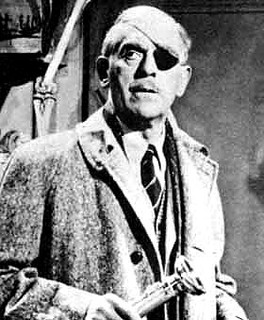 "In chronological order, first we have Boris Karloff starring in British TV crime show of the 1950s Colonel March of Scotland Yard where he plays detective with an eye patch solving crimes others can't. I recently watched episode 16 first broadcast in 1956 called "The Stolen Crime" where the whole plot line and clues to a murder hinged on a valuable Roman coin collection in a grand mansion house and the way it was ticketed and presented giving the clues.
"In chronological order, first we have Boris Karloff starring in British TV crime show of the 1950s Colonel March of Scotland Yard where he plays detective with an eye patch solving crimes others can't. I recently watched episode 16 first broadcast in 1956 called "The Stolen Crime" where the whole plot line and clues to a murder hinged on a valuable Roman coin collection in a grand mansion house and the way it was ticketed and presented giving the clues.
 "Secondly episode 2 of The Persuaders! from 1970 starring Roger Moore and Tony Curtis (I believe more well known to a UK audience at time), called "The Gold Napoleon" features gold bullion smuggling in the form of Napoleon gold coins across the borders from Monaco where the episode is set. Roger Moore disguises himself to visit a coin Dealer in Monaco who is involved with the crime and is interesting to see how the TV company fitted out the coin shop he enters.
"Secondly episode 2 of The Persuaders! from 1970 starring Roger Moore and Tony Curtis (I believe more well known to a UK audience at time), called "The Gold Napoleon" features gold bullion smuggling in the form of Napoleon gold coins across the borders from Monaco where the episode is set. Roger Moore disguises himself to visit a coin Dealer in Monaco who is involved with the crime and is interesting to see how the TV company fitted out the coin shop he enters.
"These shows are viewable in the UK via Amazon Prime for a fee."
Thank you! -Editor
For more information, see:
Colonel March of Scotland Yard
(https://en.wikipedia.org/wiki/Colonel_March_of_Scotland_Yard)
The Persuaders!
(https://en.wikipedia.org/wiki/The_Persuaders!)
To read the earlier E-Sylum article, see:
MORE NUMISMATICS IN TV AND MOVIES
(https://www.coinbooks.org/v25/esylum_v25n10a10.html)
Tracking Morgan's Medal
Julia Casey writes:
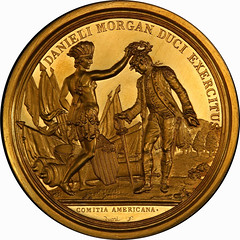 "I enjoyed reading about the Daniel Morgan medal! I thought I would make an attempt to fill in some of the gaps as to where it has been all these years. There is an intriguing mention in 1951 to a medal in the possession of Josephine Neville Strong Callahan (then age 83, of Redwood City, California) "a great great granddaughter" of Daniel Morgan. A newspaper article in the July 7, 1951, Gaffney Ledger (South Carolina) described how Mrs. Callahan wanted to move General Morgan's remains from Winchester, Virginia to Cowpens and establish a Daniel Morgan Memorial. She offered to donate these items to the memorial: "Gen Morgan's personal Bible, a portrait of him, a medal presented to him by Congress and his life story written by an uncle of Mrs. Callahan" (emphasis added).
"I enjoyed reading about the Daniel Morgan medal! I thought I would make an attempt to fill in some of the gaps as to where it has been all these years. There is an intriguing mention in 1951 to a medal in the possession of Josephine Neville Strong Callahan (then age 83, of Redwood City, California) "a great great granddaughter" of Daniel Morgan. A newspaper article in the July 7, 1951, Gaffney Ledger (South Carolina) described how Mrs. Callahan wanted to move General Morgan's remains from Winchester, Virginia to Cowpens and establish a Daniel Morgan Memorial. She offered to donate these items to the memorial: "Gen Morgan's personal Bible, a portrait of him, a medal presented to him by Congress and his life story written by an uncle of Mrs. Callahan" (emphasis added).
"Josephine Neville Strong Callahan was Jesse Barker Neville's niece. Jesse Neville is the last Neville family member documented to own the gold Daniel Morgan medal. He died in 1914 and I could not establish that he had any children. Mrs. Josephine N.T. Callahan
is listed on a record attached to Jesse Neville's findagrave.com entry as the person who arranged for his ashes to be sent from Los Angeles to Cincinnati for burial.
"An article in the American Art Journal ("Portraits of Daniel Morgan, Revolutionary War General," by David Meschutt Vol. 17, No. 3 (Summer, 1985)) Indicates that Mrs. Callahan bequeathed the General Morgan portrait to a Percy Robert Blythe when she died in 1956. Blythe donated the portrait to the Virginia Historical Society in 1959. I don't know if her medal also went to Blythe.
"Mrs. Callahan's efforts to move General Morgan's remains to Cowpens led to a squabble with another Morgan great great granddaughter, Madeline Daniels, who opposed the move. Mrs. Callahan even went so far as to issue "credentials" to a Cowpens "shovel-carrying undertaker and two assistants" who traveled to Winchester but were rebuffed. An entertaining article about this dispute, titled "Who Gets the General's Body?" was published in Life Magazine (September 3, 1951). Many thanks to Len Augsburger for locating a copy of this article! When I checked findagrave.com, the burial of Daniel Morgan is still shown as the Mount Hebron Cemetery in Winchester, Virginia.
Daniel Morgan's findagrave.com entry:
https://www.findagrave.com/memorial/2755/daniel-morgan
Jesse Neville's findagrave.com entry:
https://www.findagrave.com/memorial/79005930/jesse-barker-neville
"
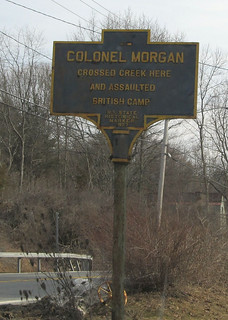
Thanks! We may never learn exactly where the medal has been all this time, but it's a miracle it has survived. -Editor
Julia adds:
"I was out driving around the vicinity of the Saratoga Battlefield for one of my jobs a couple years ago and I saw this historical marker and snapped a photo. "
To read the earlier E-Sylum article, see:
GOLD DANIEL MORGAN COMITIA AMERICANA MEDAL
(https://www.coinbooks.org/v25/esylum_v25n10a28.html)
How Insurance Shaped America
Laurence Edwards writes:
"Those interested in economic history generally might be interested in this talk hosted by the Antiquarian Society."
Underwriters of the United States: How Insurance Shaped the American Founding
with Hannah Farber
Thursday, March 31, 2022, 2 pm EDT
This program is free but requires advanced registration.
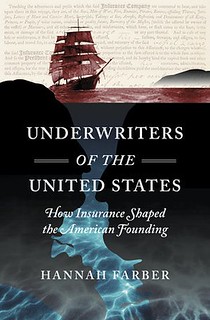 Unassuming but formidable, American maritime insurers used their position at the pinnacle of global trade to shape the new nation. The international information they gathered and the capital they generated enabled them to play central roles in state building and economic development. During the Revolution, they helped the U.S. negotiate foreign loans, sell state debts, and establish a single national bank. Afterward, they increased their influence by lending money to the federal government and to its citizens. Even as federal and state governments began to encroach on their domain, maritime insurers adapted, preserving their autonomy and authority through extensive involvement in the formation of commercial law. Leveraging their claims to unmatched expertise, they operated free from government interference while simultaneously embedding themselves into the nation's institutional fabric. By the early nineteenth century, insurers were no longer just risk assessors. They were nation builders and market makers.
Unassuming but formidable, American maritime insurers used their position at the pinnacle of global trade to shape the new nation. The international information they gathered and the capital they generated enabled them to play central roles in state building and economic development. During the Revolution, they helped the U.S. negotiate foreign loans, sell state debts, and establish a single national bank. Afterward, they increased their influence by lending money to the federal government and to its citizens. Even as federal and state governments began to encroach on their domain, maritime insurers adapted, preserving their autonomy and authority through extensive involvement in the formation of commercial law. Leveraging their claims to unmatched expertise, they operated free from government interference while simultaneously embedding themselves into the nation's institutional fabric. By the early nineteenth century, insurers were no longer just risk assessors. They were nation builders and market makers.
Deeply and imaginatively researched, Underwriters of the United States uses marine insurers to reveal a startlingly original story of risk, money, and power in the founding era.
Not directly numismatic, but of interest for anyone interested in the history of economic development. -Editor
For more information, see:
Underwriters of the United States: How Insurance Shaped the American Founding
with Hannah Farber
(https://www.americanantiquarian.org/virtual-book-talks)
BRITISH MUSEUM BOGGS OLD BAILEY NOTE EXHIBIT
Tom Hockenhull of the British Museum published an article in the Spring/Summer 2022 issue of British Museum Magazine. Thanks to Jeff Koyen for passing it along. Here's an excerpt with a photo of the Boggs Bill now on display in the Money Gallery (Room 68). Copyright Trustees of the British Museum. -Editor
Of the many artists who have investigated the intersection of art and value, the work of J.S.G. Boggs (1955–2017) is among the wittiest and most audacious. In the mid-1980s, while living in the UK as an up-and- coming artist, he began drawing money – faithful reproductions of current tender – that he would then try and spend. Acting transparently, he offered the receiver two options: they could have a genuine note in payment for a purchase, or they could accept a hand- drawn artwork imitating a note. If they accepted the drawing, Boggs asked for a receipt and the correct amount in change. The receiver was free to do what they wanted with their artwork, although on occasion his gallery would track down the drawing and offer to buy it back, at an inflated amount. ‘It's not as easy as it sounds', he once said, ‘it takes me ten hours to draw one of these things, and then another ten to spend it'.
The artist attempted to use his so- called ‘Boggs bills' to pay for everything, from meals in restaurants to rent and even his own solicitor when his work, inevitably, landed him in legal difficulty. In 1986 he wrote to the Bank of England asking it to grant permission for his note drawings. It refused and applied its prerogative to bring a private prosecution, leading to the artist's arrest and seizure of several works from an exhibition at Young Unknowns Gallery in Waterloo.
The piece is one of Boggs' 5 pound notes that was an exhibit in the trial at Old Bailey. See the evidence sticker from The Crown Court. What a great piece of numismatic and art history! -Editor
To read the earlier E-Sylum articles, see:
BRITISH MUSEUM HOLDS BOGGS OLD BAILEY NOTE
(https://www.coinbooks.org/v24/esylum_v24n44a05.html)
BRITISH MUSEUM BOGGS OLD BAILEY NOTE IMAGES
(https://www.coinbooks.org/v24/esylum_v24n49a11.html)
VOCABULARY TERM: HUBBING PRESS
Here's another entry from Dick Johnson's Encyclopedia of Coin and Medal Terminology. We collectors focus on the end product of the manufacturing process, but there's much to be learned about coins and medals by understanding the way they're made. Computer design techniques are changing the modern process, but aspects of the traditional method remain. Here's how designs are duplicated in hard metal. Even a coin initially designed on a computer screen must still be struck from a die to create the end product. -Editor
Hubbing Press. A press of tremendous power, used to duplicate a design in metal from a hard master to a soft steel block. Also called multiplying press, such a press is employed to duplicate dies by forcing two steel blocks into each other, called a squeeze. One steel block contains the design to be reproduced, it is hardened.
The other steel block has been prepared to receive the design by: (1) smoothing the top and bottom, making the two surfaces absolutely parallel, (2) machining a cone or dome on the top, (3) polishing smooth the cone or dome surface to receive the design, and (4) by annealing the steel until die body is dead soft. The hub and the prepared die block are placed within a hubbing retainer, a collar to hold the two in correct alignment during the squeeze.
Early screw presses were employed to do basic hubbing and continued to be used for nearly 400 years. In the 19th century specialized screw presses were built to do only hubbing by making heavier frames, longer cross beams and counterweights for greater leverage. In the 20th century hubbing presses have seen their greatest improvement, with greater pressure by hydraulic power and compressed oil or water in a closed chamber providing the powerful force.
History of hubbing presses. Very primitive hubbing occurred by forging a hard steel into a soft steel with a heavy hammer blow; this was how hubbing was use until the early 16th century. Undoubtedly when the first screw presses was developed (about 1506) the same press used for striking would also be used for hubbing (if the screw press operator could exert enough pressure). The U.S. Mint accomplished this by removing the feed and ejection mechanisms of the steam powered press to do the hubbing.
Manual screw presses were used from the 16th century even up to the 20th century. However once the collar and ejection system, or the automatic feed and delivery mechanism were installed into the screw press for striking (both developed about 1790), the press used for striking was no longer available for hubbing. Thus mints required separate screw presses, the largest and strongest was reserved for hubbing, all others for coining. The Royal Mint, London, developed a specialized screw press used only for hubbing in the early 1850s.
Hubbing requires two to three times the pressure used to strike coins, but this was accomplished by man power. Two stout men were required on opposite ends of a balance beam, by pressing on the beam and walking in a circle around the press drove the shank downward (by spindle threads). The hub and die blank were pressed into each other to effect the squeeze. Hubbing presses were made of heavy frames, with longer beams and counterweights added to gain more leverage.
It was only when hubbing presses became hydraulic (and operated by electricity after 1890) that manually operated hubbing presses with screw mechanism were replaced, although the British Royal Mint had an electrified screw press in the 1950s and 1960s which it used for hubbing.
Modern hubbing press characteristics. The modern hubbing press contains a bed, two shanks, and a gauge to indicate the power derived by the hydraulic force. Hubbing presses for coin and medal die hubbing range from 300 to 1000 tons pressure per square inch.
The time in which the squeeze occurs (closing speed) is important – slower is better – and modern presses have been improved to control not only the closing speed but also to control a longer dwel when the shanks are fully extended (this allows more flow time for surface movement). Also modern hubbing presses control initial impact, pressing speeds, pressure, thickness and depth penetration.
Specialized hubbing presses can also be either upstroke or downstroke – the direction in which the power is derived. A lever turns on/off the hydraulic valve; when turned on the hydraulic power forces the two shanks, one with the bed containing the hub and die, together. Modern presses have the hubbing occur behind a glass door. The glass is bulletproof. Hubs and dies could break during hubbing and they sometimes explode in all directions. Should such die shrapnel hit a person it is powerful enough to kill.
Thus hubbing presses are quite dangerous and are operated only by trained pressmen. Every precaution is taken that the hubbing be accomplished by safe techniques.
References:
C66 {1988} Cooper pp [early] 159-165, [modern] 235.
O37 {1977} Julian.
To read the complete entry on the Newman Numismatic Portal, see:
Hubbing Press
(https://nnp.wustl.edu/library/dictionarydetail/516071)
DIESINKERS ALEXANDER AND ANTHONY MORIN
American Numismatic Biographies author Pete Smith submitted this article on the Morin family of diesinkers. Thanks! -Editor
Most weeks I write about some name that is well known in numismatics. This week my topic is more obscure.
In his book Who's Who Among American Medalists, D. Wayne Johnson mentions confusion between two diesinkers, Alexander and Anthony Morin. I have new information on both.
My thanks to Julia Casey for assistance with the research.
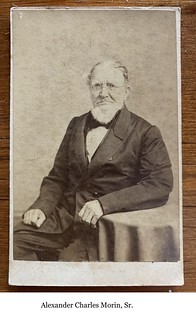 Alexander was born in France about 1790, the son of John Morin ( -1832), a silversmith and chaser. Alexander joined his father in making silver-hilted swords during the War of 1812. A silversmith mark of A. C. Morin is attributed to Alexander.
Alexander was born in France about 1790, the son of John Morin ( -1832), a silversmith and chaser. Alexander joined his father in making silver-hilted swords during the War of 1812. A silversmith mark of A. C. Morin is attributed to Alexander.
Alexander married Mary Harwood (1775-1839) on June 27, 1813. Their children were Cecelia Margaret (1817-1869), Anthony (1823-1892), Alexander Charles (1827-1904), Mary Ann (1831-), Caroline, and Louise. His wife is also listed in the 1850 census as Tacy Thomas Morin (1797-1883), an indication that he was apparently remarried between 1839 and 1850.
Morin's work on medal dies may have been a small part of his business. Much more important was his production of dies for embossed leather book bindings. In the (Philadelphia) Public Ledger of May 25, 1852, he ran an ad as a Die Sinker at 86 Walnut Street. In 1856, he was on the northeast corner of 8th and Walnut, two blocks south and six blocks east of the second Mint.
In 1858, Boyd's co-partnership and residence business directory of Philadelphia City lists Morin, Alexander C, die sinker, 111 S. 8th, b. 712 Green
in the alphabetical listing. The classified listing has about twenty-five listings for engravers and die sinkers including Alexander C. Morin. Anthony is not mentioned.
The 1860 census gives his profession as die sinker. In the 1850 and 1870 census, his name is spelled Moran.
The 1870 Gopsill's Philadelphia Business Directory lists Morin, Alexander C., 302 Walnut. That year he ran an ad in the Public Ledger with an offer to sell the tools of a die sinker.
He died (of old age) on November 12, 1879, and is buried in Lafayette Cemetery in Philadelphia. His death certificate indicates his profession as die sinker.
Alexander was not a die sinker but is mentioned because he had the same name at the same time. He was born in Philadelphia on March 4, 1827, the son of Alexander and Mary.
He married Elizabeth Catherine Slocumb (1848-1908) on December 23, 1867. Their children were Elizabeth (1868-1962), John (1870-1944), Cecelia (1872-1881), Alexander Francis (1881-1953), William Robert (1883-1969), and George Ellis (1885-1977).
In the 1850 census he is listed in Louisville, Kentucky, as a carpenter. He moved to Houston in 1852 as a building contractor. Seeing a need for public notices, he founded the Daily Court Review in 1889. The paper has remained with the Morin family over four generations.
Alexander died in Houston, Texas, on December 3, 1904, and is buried in Glenwood Cemetery in Houston.
Anthony was born in Philadelphia in 1823, the son of Alexander and Mary. Anthony married Sarah Butcher (1828) on October 15, 1845. Their children were Ella (1848), Charles (1852), and Samuel (1858).
In the 1850 and 1860 census he was listed as a silver chaser. In the 1870 census, Anthony is listed as a die cutter while his son, Charles is an apprentice to a die cutter. In the 1900 census, Charles and Samuel are both listed as die cutters. Neither are linked to known medals.
Anthony served with the Pennsylvania 90th Regiment, Company D, from 1861 to 1864. He was severely injured in the jaw at Antietam on September 17, 1862, and mustered out as a Captain.
The 1870 Gopsill's Philadelphia Business Directory lists Morin, Anthony, 101 S. 8th. This is the same as the 1858 address for his father. It is six blocks east of the second Mint and two blocks north of the current address for his father.
He died in Philadelphia of pulmonary tuberculosis on May 13, 1892, and is buried at Mount Peace Cemetery in Philadelphia. His death certificate gives his profession as engraver.
The early classic references are no help.
American Engravers and Their Works (1875) by William Spohn Baker does not list Morin.
American Engravers on Copper and Steel (1907) by David McNeely Stauffer does not list Morin.
Biographical Dictionary of Medalists, Vol IV (1909) by Leonard Forrer lists A. C. Morin without a first name.
Morin is credited as engraver for the Pennsylvania State Agricultural Society medal, Julian AM-65, first struck in 1855. At the bottom of the obverse is A. C. MORIN FECIT. PHILAD.
Julian
attributes this to Anthony C. Morin. Johnson attributes this to Alexander C. Morin.
The answer can be found in Miscellaneous Documents Read in The Legislature of the
Commonwealth of Pennsylvania, During the Session Which Commenced at Harrisburg, on the
Second Day of January, 1855. The report runs for 800 pages. Readers who wish the shorter story
may skip to page 791 and document 99 Report of the State Agricultural Society.
On page 793
is this entry:
This indicates the cost paid to the United States Mint and confirms Alexander C. Morin as the diesinker.
Two dies have the A. C. M . initials. The Great and Good
medal (Baker 357) has a Washington
bust with A. C. M. on the truncation. The Crystal Palace medal (Baker 361) has a Washington
bust with A. C. M. on the truncation. Baker credits both to Anthony C. Morin and states that
Morin died in 1873. Johnson agrees with attribution to Anthony. Neil Musante (Musante 191)
attributes it to Alexander.
Edmund B. Sullivan in American Political Badges and Medalists 1789-1892 attributes a Henry Clay medal (HC 1844-23) to Anthony C. Morin.
I believe attribution to Anthony C. Morin has been based on speculation rather than contemporary documentation and these pieces are more likely the work of Alexander C. Morin. Can such documentation be found?
Thanks! Can anyone help with these further questions? -Editor
DON EVERHART'S CAREER IN COINS, PART 7
With permission, we're republishing excerpts of former U.S. Mint Sculptor-Engraver Don Everhart series published by CoinWeek beginning in April 2018. -Editor
During my 13+ years as a sculptor-engraver for the United States Mint, I had the opportunity to work on Congressional Gold Medals for many prominent leaders and heads of state. Additionally, I had the honor to work on two Presidential Medals.
More about them later.
The Dalai Lama
One of my favorite Congressional Gold Medals (CGMs), however, was for the Dalai Lama. I designed the obverse and actually got to meet His Holiness.
Tenzin Gyatso, born in Tibet, became the 14th Dalai Lama in February of 1940 and assumed full duties in 1950 at the age of 15. He was awarded the Congressional Gold Medal in 2007. For his medal, His Holiness requested a portrait of himself along with the Himalayan Mountains in the composition. The engravers were all tasked with working up designs for the medal sometime in 2006. One of my designs featured the Dalai Lama with his hands folded in prayer in front of the Himalayan mountain range.
I had a good portrait reference of the Dalai Lama's head but I wanted to show him in prayer. I recruited Jim Licaretz, one of the staff engravers, to pose for me with his hands folded. I took a snapshot and used the photo as additional reference for my design. So when you are looking at the medal, you are looking at Jim's hands (who's going to know?).
I then added the mountain range behind him and a ribbon with the wording Act of Congress 2006
. Additional text included 14th Dalai Lama of Tibet
around the top perimeter of the design.
The CGM Ceremony was held in the Capitol Rotunda in February of 2007. Several members of the Mint staff were invited to meet with His Holiness in his hotel suite before the ceremony. My boss, John Mercanti, and Ed Moy, the Director of the Mint, accompanied us to the much-anticipated meeting. It was THE hot ticket!
We all sat in a circle with the Dalai Lama to my immediate left. Everyone spoke briefly to him and when it got around to me I mentioned that I had gotten quite a feeling of serenity when working on this medal, which I directly attributed to him. He leaned forward to speak to me and I expected to hear the secret to eternal happiness. Instead he asked Did you give me hair?
while brushing the top of his head. I assured him that I did. We all had a laugh and then proceeded to talk about male pattern baldness.
Later I reflected on how surreal this was.
After the sit-down meeting the Dalai Lama gave each of us prayer shawls. Before leaving the hotel suite we all posed with His Holiness for pictures. We left feeling like we had met one of the most consequential figures of our lifetime.
To read the complete original article, see:
Don Everhart: My Career in Coins, Part 3 – Historic Figures & Heads of State
(https://coinweek.com/us-mint-news/don-everhart-my-career-in-coins-part-3-historic-figures-heads-of-state/)
To read the earlier E-Sylum article, see:
Don Everhart's Career in Coins, Part 6
(https://www.coinbooks.org/v25/esylum_v25n10a20.html)
ANA 2022 CLUB PUBLICATIONS COMPETITION
The ANA is accepting submissions for their 2022 Club Publications Competition. Don't forget! - the deadline is coming up April first. -Editor
Submissions Accepted for ANA's Club Publications Competition
The American Numismatic Association (ANA) is currently accepting submissions for the 2022 Barbara J. Gregory Outstanding Club Publications competition. Awards will be presented in four categories: local, regional, specialty and electronic. The contest is open to member clubs that are current with their ANA dues, and do not have an elected or salaried ANA officer as editor or assistant editor. Completed submissions must be received by April 1.
Submissions must include a complete set of 2021 publications or three different emailed samples of online publications from 2021. Also required are the category of submission (local, regional, specialty or electronic); the editor's name; and the name, address, phone number and email address of the submitter.
Judging Criteria
Publications are rated on a scale of 1 to 5 (1-poor, 5-excellent) in the following areas: General appearance/appeal; consistency of format; neatness/readability; presentation of club-related news; presentation of numismatic/scholarly information; aptness/quality of illustrations; and originality/creativity. The size of the club and the amount of funds expended is not a factor in judging.
Completed electronic entries can be emailed to omccommons@money.org. All others should be sent to:
ANA Publications Department
c/o Olivia McCommons
818 N. Cascade Avenue
Colorado Springs, CO 80903
Honors will be presented at the ANA World's Fair of Money® in Chicago.
To view the submission guide online and to see past winners, visit money.org/outstanding-club-publications. For more information, contact omccommons@money.org.
ANA 2022 YOUNG NUMISMATIST LITERARY AWARDS
Also coming up April first is the deadline for submissions to the ANA Young Numismatist Literary Awards. -Editor
Submissions Accepted for ANA Young Numismatist Literary Awards
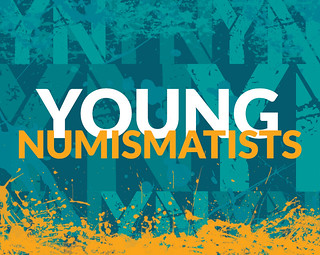 Submissions for the American Numismatic Association's (ANA) annual Young Numismatist Literary Awards competition are being accepted through April 1. The awards were established to encourage young writers in three age groups, all of whom will compete for cash awards and numismatic books.
Submissions for the American Numismatic Association's (ANA) annual Young Numismatist Literary Awards competition are being accepted through April 1. The awards were established to encourage young writers in three age groups, all of whom will compete for cash awards and numismatic books.
Article submissions will be evaluated by a panel of judges that includes Bill Fivaz, Mitch Sanders and Kenneth Bressett.
Eligibility
To compete in this year's competition, participants must be ANA members. Submitted articles will focus on a numismatic topic of the competitor's choice.
Bill Fivaz Young Numismatist Literary Award
Ages: 8-12
Article should display basic knowledge of a numismatic topic. Creativity and original conclusions are encouraged. Suggested length: 450-900 words.
Q. David Bowers Young Numismatist Literary Award
Ages: 13-17
Article should display advanced knowledge of a numismatic topic. Logically presented facts and original conclusions are encouraged. A bibliographic list of sources is recommended, but not required. Suggested length: 900-1,800 words.
Kenneth E. Bressett Young Numismatist Literary Award
Ages: 18-22
Article should display in-depth knowledge of a numismatic topic. Logically presented facts and original conclusions are required, as is a bibliographic list of sources. Inclusion of charts, graphs, tables or other illustrations is encouraged. Suggested length: 1,800-3,600 words.
Guidelines for Submissions
When submitting articles:
- Provide ANA-member number, category of submission and contact information (email, phone number and address) on the first page.
- Include author's name and award category in the file name.
- Submissions are accepted in Microsoft Word or PDF format only.
- Up to three submissions per author are allowed.
- Submissions previously published in The Numismatist will not be accepted.
Award Structure
The following prizes will be awarded in each of the age categories:
- First Place: Certificate and $500 cash prize, plus a $500 voucher to help build a personal library of numismatic books produced by Whitman Publishing. (International winners will be required to pay book shipping costs.)
- Second Place: Certificate, plus a $200 book voucher from Whitman Publishing.
- Third Place: Certificate, plus a $100 book voucher from Whitman Publishing.
Completed entries should be emailed to sstewart@money.org.
For additional information, please contact sstewart@money.org.
NLG 2022 AWARD COMPETITION
And don't forget the awards from the Numismatic Literary Guild. Here are the rules for their 2022 competition. -Editor
Numismatic Literary Guild 2022 Award Categories & Rules
Please read the following rules and requirements very carefully. Submissions that do not adhere to the rules may be disqualified.
- All submitters must be paid-up members of the NLG as of May 1, 2022.
- All submissions are to be sent to David W. Lange, Awards Coordinator, POB 110022, Lakewood Ranch, FL 34211.
- Please do not send a membership application with your submissions. Those should be sent to: Maurice Rosen, Treasurer NLG 1120 Old Country Road, Suite 306, Plainview, NY 11803
- All submissions must have been published between May 1, 2021 and April 30, 2022.
- Each copy of each entry must be accompanied by its own printed cover sheet, and this applies to electronic submissions, too. The sheet must include the applicable category and sub- category, the name and date of its publication and the name and contact information of the submitter. See the sample cover sheet below.
- No more than one entry per category is permitted, except where the instructions specifically require multiple examples of work, such as with columns.
- Please, no rubber bands or paper clips, as these may become separated in transit. Cover sheets should be stapled to the front of each entry, though exceptions will be made for hardcover books and non-printed media.
- Aside from the All-Around Portfolio Category, where presentation does count, please don't provide elaborate packaging for your entries. This will never be seen by the judges.
- Submissions must be received by June 4, 2022 to be eligible for competition.
Sample Cover Sheet
CATEGORY 4b NUMISMATIC COLUMNS UNITED STATES COINS
Coins Coins Coins Journal
"The Coin Column" June, 2021 February, 2022 April, 2022
John Q. Numismatist POB 1234 Frostbite Falls, MN 56688 Jqn@coinland.net
CATEGORIES
1. BEST SPECIALIZED BOOKS (Three printed copies are required for each entry, unless the entry is an e-book exclusively)
a. United States or Related Coins
b. Ancient or Medieval Coins
c. World Coins (1500 to Date)
d. Paper Money
e. Tokens or Medals
f. Numismatic Investment or Marketplace g. Numismatic History or Personalities
2. BOOK OF THE YEAR (Books submitted in the specialized categories are automatically considered for Book of the Year, and submitting additional copies is not required.)
This is the printed or electronic media work having the greatest potential impact on numismatics. Criteria include overall reader appeal, research quality, photographic and graphic excellence, cover and typography where applicable.
3. NUMISMATIC FEATURE ARTICLES (Three copies are required for each entry.)
a. United States Coins – Early (Coin types initiated before 1900)
b. United States Coins – Modern (Coin types initiated after 1900)
c. Ancient or Medieval Coins
d. World Coins (1500 to Date)
e. Paper Money
f. Tokens or Medals
g. Numismatic Investment or Marketplace h. Numismatic History or Personalities
h. James L. Miller Memorial Award – Article or Story of the Year
(Articles submitted in the specialized categories are automatically considered for this award, and submitting additional copies is not required.)
4. NUMISMATIC COLUMNS (Three copies each of three different installments are required, and each must be the work of a single author or pair of authors.)
a. United States Coins – Early (Coin types initiated before 1900)
b. United States Coins – Modern (Coin types initiated after 1900)
c. Ancient or Medieval Coins d. World Coins (1500 to Date) e. Paper Money
f. Tokens or Medals
g. Numismatic Investment or Marketplace h. Numismatic History or Personalities
5. PERIODICALS (Three copies each of three different issues are required.)
a. Best Investment Newsletter
Criteria include overall reader appeal, quality of research and writing, and graphics, as applicable.
b. Best Professional Periodical
To be submitted by the publisher or editor of any daily, weekly, monthly, quarterly or annual for-profit numismatic publication in the U.S. or overseas. Criteria include overall numismatic appeal, features, departments, graphics, journalistic and editorial excellence as applicable.
c. Best Club or Not-for-Profit Periodical – Large Circulation
Open to any local, regional, national or international not-for-profit numismatic organization in the U.S. or overseas having a circulation of 1500 or more per issue.
d. Best Club or Not-for-Profit Periodical – Small Circulation
Open to any local, regional, national or international not-for-profit numismatic organization in the U.S. or overseas having a circulation of fewer than 1500 per issue.
6. WEBSITES (Submit url or three printed copies of selected entry pages.)
a. Best Online News Website
b. Best Dealer or Industry Website
c. Best Non-Trade Website
This category is for web sites maintained by coin clubs and other non-commercial organizations and individuals devoted to the coin hobby.
d. Best Numismatic Social Media Platform or Coin Collector Forum
The award will be presented for the best numismatic-themed page or feed posted on a collector forum site (or message board) or social media site such as Facebook, Instagram, Twitter or Google Plus. Entries will be judged based on the quality of articles, external links, and graphics posted. Audience engagement also will be considered by the judges.
e. Best Blog
This award recognizes the best interactive blog that communicates information and personal commentaries about the numismatic hobby.
7. AUCTION OR FIXED-PRICE CATALOGS (Submit three copies of each entry.) Criteria include cover design, overall eye appeal, format, graphics and layout, research and quality of description. Entries may be submitted by auction firm, auctioneer or cataloger. (NOTE: Submitters may enter each of the four sub-categories, but only one entry per each sub-category is permitted.)
a. Best U.S. Coin Auction Catalog
b. Best World Coin Auction Catalog
c. Best Paper Money Auction Catalog
d. Best Book or Exonumia Auction Catalog
e. Best Single Auction Lot Description in Any Category
8. AUDIO-VIDEO
a. Audio (Entries must include three standard-size CDs, flash/thumb drives or URLs)
Best audio presentation for a spot news story, a feature program or a continuing series involving numismatics. Emphasis will be placed on the quality of production, rather than the subject matter.
b. Video (Entries must include three standard-size DVDs, flash/thumb drives or URLs)
Best video presentation for a spot news story, a feature program or a continuing series involving numismatics. Emphasis will be placed on the quality of production, rather than the subject matter.
c. Still Photography (Entry must include three sets of five examples each in either hard copy or electronic format.)
This applies to both commercial and non-commercial photography of numismatic subjects, and entries may include examples of each.
d. App (For physical media three copies of the work need to be submitted. For digitally distributed software or apps, three copies must also be provided, and if the entry is distributed on the Android or Apple store, written instructions must be provided about how to locate and download the app. Each entry must be accompanied by a written statement citing date(s) of first use.)
Best presentation of new numismatic-related software or mobile application published in CD- Rom, DVD, App Store or any other electronic format or electronic delivery system.
e. Presentation Software (Entries must include three electronic copies of the program. Each entry must be accompanied by a written statement citing date(s) of first use.)
Best presentation of new numismatic-related programming utilizing PowerPoint or a similar tool.
9. SPECIAL AWARDS
a. Lee Martin Founder's Award - Best All-Around Portfolio (Only one copy of the portfolio entry needs to be submitted and may be submitted as PDF files on a flash/thumb drive. Items included in the portfolio may also be submitted in other relevant categories at entrant's option.) Collection of writings and/or photographs and related items demonstrating numismatic writing ability and versatility published within the contest year. The emphasis is on quality, not quantity, and organization and presentation will count as heavily as volume.
b. The Ribbit
This award recognizes an individual who has achieved prominence in numismatics while maintaining approachability, a sense of humor and essential modesty. The winner is selected by the previous year's recipient.
c. The Clemy
The winner of this award, the Guild's highest honor, is chosen by the previous year's recipient from a list of nominees provided by the NLG Board of Directors.
NLG reserves the right to limit the number of plaques for any given entry, with the number to be determined at its discretion. NLG will provide plaques only for the persons named in an entry when it is originally submitted. Winners living in countries other than the United States, Canada and Mexico will receive certificates and cash awards, rather than plaques. The cash award will be $50 for first-place winners.
For more information on NLG , see:
https://www.nlgonline.org/
DAVISSONS AUCTION 41 ROMAN COINAGE
In an email to clients this week, Lief Davisson discussed Roman coinage in the upcoming Davissons Auction 41. -Editor
Today we move on to the Roman section–55 carefully selected lots.
Our sale opens on several pieces of Roman gold: Vespasian with a rare triumphal Pax-Nemesis reverse and a handsome high grade Gordian III. Several choice gold pieces from our small Byzantine section deserve mention as well, particularly the fine style mint state Philippicus (Bardanes) solidus.
The Roman Republic opens on two less commonly seen early litrae, before a short selection of scarce and notably attractive denarii–a severed barbarian head, a desultor who will shortly leap from one galloping horse to another, a kneeling Nabatean king, and a goat whose days are numbered–the diversity of Republican coinage has always made it a personal favorite.
The Roman Imperatorial section is brief but choice–the beautiful bust of Sibyl Herophile and the unusual yet as struck posthumous portrait of Julius Caesar are both uncommonly fine, and the old collection toning on the P. Accoleius Lariscolus denarius well matches its century old pedigree.
The Roman Imperial section is highlighted by several beautiful pieces–the Domitian with Pegasus is among the most beautiful denarii we have ever handled, and it is well accompanied by choice issues of Trajan, Antoninus Pius, and Septimius Severus at Emesa. The section closes with a few particularly nice bronzes, including one pedigreed directly to its hoard's discovery in 2007.
The Roman Provincial offering (included chronologically with the Imperial) is no slouch either–featuring a concise selection of attractive and unusual silver and bronze issues from Spain to Syria, of particular appeal are several high grade larger module Æ of Caracalla, Geta, and Elagabalus.
The lots shown here are a good overview, but there is always more to see! Perhaps a coin not included here will be exactly what your collection has been missing, why not take a look?
And stay tuned as we move on to the rest of the sale, with a few more highlights between now and the close–British coinage and tokens, select World, and some remarkable U.S. offerings are still to come.
For more information, see:
https://davcoin.com/
To read the earlier E-Sylum articles, see:
DAVISSONS AUCTION 41 GREEK, JUDAIC SELECTIONS
(https://www.coinbooks.org/v25/esylum_v25n09a27.html)
DAVISSONS AUCTION 41 ELECTROTYPES
(https://www.coinbooks.org/v25/esylum_v25n10a26.html)
DAVISSONS AUCTION 41 SELECTIONS
In a final email to clients this week, Allan Davisson discussed some additional highlights of the upcoming Davissons Auction 41. -Editor
 Micro and macro, generalists and specialists, detail or big-picture oriented: the world of numismatics offers challenges and satisfactions for different perspectives, and in many cases the overlap is what makes the field even more exciting.
Micro and macro, generalists and specialists, detail or big-picture oriented: the world of numismatics offers challenges and satisfactions for different perspectives, and in many cases the overlap is what makes the field even more exciting.
The effort of finding and filling in elements of a particular series brings the satisfaction of putting something together that not only fulfills a goal, it often leads to new insights and depths of understanding that are elusive until varieties and progressions become more obvious. This is why so much of what is published about coins, tokens and medals is authored by committed collectors, amateurs
in the best sense of the term—people whose interest is personal, who love what they are doing.
This means an auction catalog should have data—weights, sizes, concise descriptions, accurate references, reliable grading and, perhaps most importantly, preparation by people with an underlying understanding of the material itself, and a love for it. Interestingly, almost every catalog we put out gets comments back from specialists who know more than we do. (See lot 162 for a key example.) This would not happen unless there was a shared basis of understanding about the material we offer.
Over the several decades we have been writing catalogs and sales we have focused on ancient Greek and Roman coins, specialized in the various series of British numismatics from the over 2000 years the area covers, and have gone into other areas. For the three of us, we feel privileged to have a profession that allows us to indulge our passion, where we never suffer from boredom, always with something new to learn about, to handle, to offer.
While many collectors become specialists and focus on one area, the breadth of what numismatics
includes means that there is almost always something new under the sun
that can draw interest.
There is fine artistry, decorative expression, political and social commentary—all the things that are considered art
that are present in numismatics. I recently had to fill out a government form where I was asked to classify our business. One choice was art dealer
and I thought seriously about marking that though I finally decided it was too narrow.
But that is one of the great appeals of what we handle—artistic merit is one of the major criteria we use when considering what should be selected for a sale.
There is also history and the ever-fascinating realization that what we are handling is actually a physical remnant of times and events past.
I spent some time this evening looking over the catalog once again. It has been a few weeks since my part of its preparation was finished so revisiting it now that the end of the sale is so near seemed particularly appealing. A few things really stood out for me:
The rare Byzantine gold solidus rendering an Armenian general in fine artistry and in Mint State condition. (Lot 6)
The Renaissance artistry of a coin that represented the need for a new denomination because of changing economic currents—and a rare non-London issue as well, the York half ryal of Edward IV. (Lot 8)
The excitement of the American west and the gold rush and the mention of Pikes Peak in Colorado. I could see Pikes Peak out of the front window of the house I grew up in. (Lot 13)
The powerful presence conveyed by artistry and centering on the beautiful Athenian owl. (Lot 81)
Domitian's portrait and Pegasus on the Roman denarius and the spectacular toning that graces it. (Lot 118)
The clear, unmarred image of Philip II with Mary on an English shilling... (Lot 170)
...and his image again on a coin of Naples. (Lot 319)
Charles I riding high on a nearly flawless and spectacular halfpound... (Lot 174)
...and then gone forever by the time of the final siege at Pontefract as the coin vainly declared his son the new king. (Lot 176)
The simple beauty of an exceptionally fresh (and extremely rare) Scottish crown issued for a few months only during a time of economic turmoil. (Lot 202)
The heft of a sixpence piece meant to be worth in commerce what it was in copper—a failed effort both because it was too hard to produce and too heavy to carry (the finest known example). (Lot 302)
The set of replicas of America's beautiful 1796 coinage—available for little more than the bullion value of the pieces and rendered in meticulous detail. (Lot 331)
You have a few days left to page through the print catalog or browse the internet.
Then the conclusion arrives Wednesday morning, March 16th at 10:00 A.M. US Central Daylight Time. The hour change occurs a couple of weeks earlier in the United States than it does in Europe. I don't know why—perhaps eagerness for winter's end or simply national impatience. But it does mean a 3:00 P.M. GMT start time for our 41st major sale.
For more information, see:
https://davcoin.com/
To read the earlier E-Sylum articles, see:
DAVISSONS AUCTION 41 GREEK, JUDAIC SELECTIONS
(https://www.coinbooks.org/v25/esylum_v25n09a27.html)
DAVISSONS AUCTION 41 ELECTROTYPES
(https://www.coinbooks.org/v25/esylum_v25n10a26.html)
THE BOOK BAZARRE
WORLD BANKNOTE AUCTIONS SALE 23
Here's the announcement for World Banknote Auctions upcoming Live Sale 23. Many rare and interesting items. -Editor
This week World Banknote Auctions has listed Live Sale 23, which closes in two different segments. The first segment, the traditional live sale, closes on March 24th, 2022, with live bidding that day at 1 PM Eastern / 10 AM Pacific. The following day, on March 25th at 1 PM Eastern / 10 AM Pacific an additional segment closes in a timed auction (no live bidding, although lots may be extended if a bid is received 10 minutes before closing). Live Sale 23 offers 804 lots from around the world, with select highlights including key notes from around the world, classic type notes and modern issues in high grade. Some highlights are selected below, the entire catalog can be viewed on the company's website, www.worldbanknoteauctions.com
Lot 23056 is a 1922 dated 5 Dollar from British North Borneo (Pick-4b). This piece, which has been graded Very Good 10 NET by PMG (with comments for edge damage and rust) is part of a banknote series that has become much in demand in recent years. While this piece shows signs of circulation it is still complete and intact, something that cannot be said of many pieces of this era and British protectorate, which today is part of Malaysia. Like many pieces from this region this series has seen a sharp uptick in demand in recent years, and offerings such as this one have become increasingly more infrequent. This piece carries an estimate of $3,000-$4,000.
To read the complete lot description, see:
British North Borneo 1.12.1922 P-4b PMG Very Good 10 NET 5 Dollars
(https://bid.worldbanknoteauctions.com/lots/view/4-58Q5LL/british-north-borneo-1121922-p-4b-pmg-very-good-10-net-5-dollars)
Lot 23065 is a PCGS Gem Uncirculated 66 PPQ graded example of a Canadian $1000 banknote from the 1954 (modified) series with Lawson – Bouey signature combination identified as BC-44d. Canadian $1000 notes were issued until the end of the 20th century and remain popular with collectors. This example is perfect as a high-grade type example and carries a pre-auction estimate of $2,000-$2,500.
To read the complete lot description, see:
Canada 1954 BC-44d PCGS Gem UNC 66 PPQ 1,000 Dollars
(https://bid.worldbanknoteauctions.com/lots/view/4-58Q5M3/canada-1954-bc-44d-pcgs-gem-unc-66-ppq-1-000-dollars)
Lot 23138 is an iconic 10,000 Francs specimen from the Equatorial African States (Pick-7s), undated (circa 1968) and graded Choice Extremely Fine 45 by PMG. This iconic issue is the highest denomination of this series and is rare in any format. It features the portrait of Emperor Bokassa I of the Central African Republic and scenes from that country's capital, Bangui. An unusual note not only for its high face value but also for the fact that it was printed in France for one of the world's poorest countries at the time, this may have been intended solely for the purpose of boosting Bokassa's image. This classic post-colonial African note carries a pre-auction estimate of $2,000-$2,500.
To read the complete lot description, see:
Equatorial African States ND (1968) P-7s PMG Choice Extremely Fine 45 10,000 Francs (Specimen)
(https://bid.worldbanknoteauctions.com/lots/view/4-58Q5Q5/equatorial-african-states-nd-1968-p-7s-pmg-choice-extremely-fine-45-10-000-francs-specimen)
Lot 23124 is an iconic specimen issue from Honduras printed by the American Banknote Company. This 100 Pesos from the 1889 series (Pick-24s) is graded Choice Uncirculated 63 by PMG with a comment for pinholes. Virtually unobtainable in issued format, specimens such as this showcase the design and are perfect representatives for the series. A survey of recent auction results has revealed no fully printed specimen examples of this type selling at public auction in the past decade or so (a few one-sided proofs have been offered but are typically more available). This bright and colorful note features a pre-auction estimate of $3,000-$4,000.
To read the complete lot description, see:
Honduras 1.10.1889 P-24s PMG Choice UNC 63 100 Pesos (Specimen)
(https://bid.worldbanknoteauctions.com/lots/view/4-58Q5TT/honduras-1101889-p-24s-pmg-choice-unc-63-100-pesos-specimen)
Lot 23232 is a Law of 1931 (issued 1941-42) 1/4 Dinar from Iraq (Pick-12), graded Fine 12 by PMG (with a repaired
comment). While most notes for the Kingdom of Iraq were printed by the British firm of Bradbury & Wilkinson, Co. the outbreak of World War II meant that newly printed banknotes could not always be delivered safely to Iraq. As a result, a supplemental order was placed for four denominations (100 Fils, 1/4 Dinar, 1/2 Dinar and 1 Dinar) at the Nasik Security Printing Press in India. While the same basic design was used, there are some small differences, particularly in the font of the serial numbers. Issued in relatively small quantities, all four denominations are scarce to virtually unobtainable (the 100 Fils is believed to be unique in issued form, and very few of the 1/2 Dinar are known to exist), these India Print
notes are among the most desirable of all Iraqi banknotes. This 1/4 Dinar carries a pre-auction estimate $3,500-$4,000.
To read the complete lot description, see:
Iraq 1931 (ND 1941) P-13 PMG Fine 12 1/4 Dinar (India Print)
(https://bid.worldbanknoteauctions.com/lots/view/4-58Q5VD/iraq-1931-nd-1941-p-13-pmg-fine-12-14-dinar-india-print)
Lot 23261 is a 100 Pound from the Ulster Bank Ltd. in Northern Ireland (Pick-330a) dated 1st March 1977 and graded Gem Uncirculated 66 EPQ by PMG. While this might appear like a relatively common modern banknote, this issue is deceptively scarce in high grade. 100 Pounds represented a huge sum of money in Northern Ireland at the time of issue and very few were put aside at the time of issue for today's collectors to enjoy. Within the series there are some very scarce dates and denominations, including this one, which carries a pre-auction estimate of $1,000-$1,200.
To read the complete lot description, see:
Northern Ireland Ulster Bank 1.3.1977 P-330a PMG Gem UNC 66 EPQ 100 Pounds
(https://bid.worldbanknoteauctions.com/lots/view/4-58Q5WZ/northern-ireland-ulster-bank-131977-p-330a-pmg-gem-unc-66-epq-100-pounds)
Lot 23266 is a ND (1948-51) 1 Pound from the Anglo-Palestine Bank in Israel (Pick-15a) graded Gem Uncirculated 66 EPQ by PMG. Issued shortly after the creation of Israel, this is the same basic design as the type later issued by the Bank-Leumi (National Bank), but is much scarcer, especially in such a lofty grade. Tied for the finest in the PMG population report, examples at this grade level are very seldom offered for sale. It carries a pre-auction estimate of $3,000-$4,000.
To read the complete lot description, see:
Israel ND (1948-51) P-15a PMG Gem UNC 66 EPQ 1 Pound
(https://bid.worldbanknoteauctions.com/lots/view/4-58Q5X9/israel-nd-1948-51-p-15a-pmg-gem-unc-66-epq-1-pound)
Lot 23397 is a 1920 dated 100 Pesos from the Philippines (Pick-50) graded Fine 12 by PMG. A very scarce high denomination from the Philippine National Bank, this is a type that is very seldom offered for sale in any grade. In our opinion banknotes printed for the U.S. Philippines are truly part of the American series and should be collected by every serious collector of American banknotes and as such deserve a spot in the Friedberg catalog of U.S. Paper Money. Until now, however, that has not happened and knowledge of these historic pieces remains primarily limited to world banknote collectors. This rarity carries a pre-auction estimate of $6,000-$8,000.
To read the complete lot description, see:
Philippines 2.5.1920 P-50 PMG Fine 12 100 Pesos
(https://bid.worldbanknoteauctions.com/lots/view/4-58Q64U/philippines-251920-p-50-pmg-fine-12-100-pesos)
Lot 23476 is an 1876 10 Dinara from Serbia (Pick-3), graded Extremely Fine 40 by PMG (with stained, discoloration
comments). The PMG comments might be a bit harsh on this one, as the notes were originally printed on yellowish paper and we see little signs of discoloration. Regardless, this denomination that was part of the first series for Serbia was printed in France, and appears to have never been issued. Like all early Serbian notes it is difficult to find in higher grades, and this offering carries a pre-auction estimate of $1,500-$2,000.
To read the complete lot description, see:
Serbia 1.7.1876 P-3 PMG Extremely Fine 40 10 Dinara
(https://bid.worldbanknoteauctions.com/lots/view/4-58Q69A/serbia-171876-p-3-pmg-extremely-fine-40-10-dinara)
Lot 23508 is an 1894 specimen 50 Kronor from the Kalmar Enskilda Bank in Sweden (Pick-S290s) graded Gem Uncirculated 66 EPQ by PMG (with a comment for printer's annotation
). Part of a series of private banknote issues, the Swedish Enskilda banknotes are a fascinating series worthy of further research. They were issued in many cities in Sweden, and the designs (as seen here) are well-executed and classic. In many instances issued notes are extremely rare to unknown (we have not been able to find any of this particular type and denomination, for example) but specimens are sometimes available. This 19th century Swedish banknote carries a pre-auction estimate of $2,500-$3,000.
To read the complete lot description, see:
Sweden, Kalmar Enskilda Bank 1894 P-S290s PMG Gem UNC 66 EPQ 50 Kronor (Specimen)
(https://bid.worldbanknoteauctions.com/lots/view/4-58Q6B2/sweden-kalmar-enskilda-bank-1894-p-s290s-pmg-gem-unc-66-epq-50-kronor-specimen)
To read the complete article, see:
World Banknote Auctions Presents Live Sale 23
(https://www.worldbanknoteauctions.com/news/world-banknote-auctions-presents-live-sale-23/)
KÜNKER AUCTION 363 HIGHLIGHTS
In a February 18, 2022 email, Künker listed these highlights of their Auction 363, which takes place on March 23rd and 24th. Some more nice coins here. I spy with my little eye ... another chronogram! -Editor
Lot number 2015
Flanders.
Louis of Male, 1346-1384.
1/2 lion d´or n.d. (1365), Gent.
Very rare. Extremely fine to FDC.
Estimate: 7.500,00 euros
Lot number 2030
France.
Philippe IV le Bel, 1285-1314.
Masse d´or n.d. (1296).
Very rare. Extremely fine.
Estimate: 7.500,00 euros
Lot number 2168
Russia.
Peter III. 1762.
10 roubles 1762, St. Petersburg.
Very rare. Edge worked, worn. Very fine.
Estimate: 7.500,00 euros
Lot number 2333
Austria.
Franz Joseph I. 1848-1916.
Off-metal strike in gold from the dies of
the 4 Krajzár copper piece from 1868, Kremnica.
Only a few specimen known. Proof.
Estimate: 60.000,00 euros
Lot number 2414
Mainz.
Anselm Franz von Ingelheim, 1679-1695.
Off-metal strike in gold from the dies of
the reichstaler 1682, Mainz.
Probably unique. Extremely fine to FDC.
Estimate: 50.000,00 euros
Lot number 2429
Nuremberg.
4 ducats 1631.
Extremely rare. FDC.
Estimate: 75.000,00 euros
Lot number 2592
Russia.
Alexei Michailowitsch, 1645-1676.
Jefimok 1655, overstrike on a Nuremberg taler.
Very rare. Very fine.
Estimate: 3.000,00 euros
Lot number 2825
Brunswick-Wolfenbüttel.
Rudolph Augustus, 1666-1685.
Löser of 4 reichstalers 1679, Zellerfeld.
Very rare. Extremely fine.
Estimate: 30.000,00 euros
Lot number 2931
Mecklenburg-Schwerin.
Christian I. Ludwig, 1658-1692.
Oval, gilded silver medal n.d. (1662), by J. Reteke.
Very rare. Very fine.
Estimate: 5.000,00 euros
Lot number 2940
Mecklenburg-Schwerin.
Frederick William, 1692-1713.
Reichstaler 1708, Schwerin.
Extremely rare. Extremely fine.
Estimate: 4.000,00 euros
Lot number 3024
Oldenburg.
Anton I., 1526-1573.
Taler n.d. (1538).
Very rare. Very fine.
Estimate: 10.000,00 euros
Lot number 3174
Bavaria.
Ludwig III. 1913-1918.
3 marks 1918.
Very rare. About FDC.
Estimate: 25.000,00 euros
For more information, see:
https://www.kuenker.de/
ST. JAMES OFFERS STUART DEVLIN ITEMS
St. James Auctions is offering items from the studio of coin and medal designer Stuart Devlin. Here's the press release. -Editor
NUMISMATIC ITEMS FROM THE STUDIO OF STUART DEVLIN
The Australian-born Stuart Devlin (1931–2018) was, in the words of the late HRH Prince Philip, probably the most original and creative goldsmith and silversmith of his time, and one of the greats of all time
. In the saleroom his creations appear from time to time and today they have a serious following. Devlin is less well known as a medallist, even though it was his designs for the reverses Australia's first decimal coinage in 1966, that brought him to London and opened so many doors for him for his future career. Now, on 30 March, St. James's Auctions are to sell a small but important group of numismatic items from his studio.
In 1991 he was commissioned to design the portrait reverses of a set of five coins for the Australian Mint to mark the 40th anniversary of the accession of HM Queen Elizabeth II the following year. It was to be called Masterpieces in Silver – The Royal Ladies. The auction will include five of his hand-carved portrait plasters of the Queen Mother, Princess Margaret, Princess Anne, Princess Diana and the Duchess of York. The excellent portraits are worked from portrait photographs by Stuart Devlin also in the sale. They were taken at very short notice at Buckingham Palace just prior to the State Banquet for President Mubarak of Egypt on July 23rd 1991. He had wanted to show them all wearing tiaras so he was granted the special time when not only were the ‘Royal Ladies' all present but all wearing their finest!
Other original plasters in the sale include a 1966 posthumous portrait of Winston Churchill (for a set of medals of British Prime Ministers); the Common Seal of the Greater London Council, 1964 and the lionfish reverse for the 1967 fifty-cent coin for Singapore's first decimal coinage.
Here's an excerpt from the catalogue's Foreword. -Editor
St. James's Auctions is pleased to offer items from the Studio of Stuart Devlin in our March sale 2022. The collection comprises of a good number of Australian coins which he designed alongside a group from The Royal Ladies Collection, commissioned in 1992. Here we offer the portrait photographs taken by Devlin of the Royal Ladies (The Queen Mother, Princess Margaret, Princess Anne and Diana), as well as the plaster casts which Devlin produced from these images, and finally we offer the resulting coins (lots 7 – 12).
Following the Australian coins, we offer a group of British coins from Devlin's personal collection, as well as further plaster casts which he used to create coins, and the resulting coins themselves. Particular highlights include a superb set ‘Great British Prime Ministers' comprised of six 22ct. gold medals designed by Stuart Devlin of the six prime minters between 1676 and 1965 (Walpole, Pitt the Elder, Pitt the Younger, Disraeli, Gladstone, Churchill) (lot 30), and the plaster casts which Devlin used to create some of his iconic deigns, including the plaster used for Churchill's portrait in the previous lot (lot 29) and the one used for the Common Seal of the Greater London Council (lot 31).
Devlin also amassed a collection of world items including another plaster, this one used for the Republic of Singapore's fifty cent reverse featuring the lionfish (lot 46).
Here's a biography from the catalogue, written by John Andrew. -Editor
Born in 1931, at the tender age of 13 Devlin's aim was to become an art teacher specialising in metalwork. This was achieved age 21 at Wangaratta Technical School, which he regarded as being ‘banished to the bush'. In 1956 Devlin moved to Melbourne and started teaching at Prahran Technical Art School. He combined his lecturing with part-time study at the Royal Melbourne Technical College. Within one year he gained a diploma of art in gold and silversmithing, normally a three-year full-time course, with the highest marks ever awarded. This accomplishment resulted in a two-year travelling scholarship. He persuaded London's Royal College of Art (RCA) to let him undertake its silversmithing course in two as opposed to three years. At the RCA from 1958 to 1960, he left with two degrees, one in silversmithing, the other in industrial design.
Devlin's success at the RCA resulted in his being awarded a Harkness fellowship. He chose Colombia University in New York as his base. Initially he pursued silversmithing, but then turned his attention to sculpture, which resulted in a one-man show at the Thibaut Gallery in Madison Avenue, New York. A condition of Devlin's travelling scholarship was that afterwards he should complete his teaching contract in Australia. He returned in 1963 and was appointed inspector of art schools for the state of Victoria. However, he detested the role as he realised that as a teacher he could put his ideas immediately into action, but as an inspector it would take years. He resigned after three months and began lecturing at Melbourne University.
The highly respected Joe Burke, professor of fine art at Melbourne asked Devlin if he would be interested in joining a group of well-known designers to compete for the creation of Australia's decimal coinage. He nearly declined as he considered designing coinage was a graphic design matter and he was a sculptor, but he felt he had nothing to lose, particularly as the government paid participants a handsome sum. The group met monthly with the Treasury officials. Their patrons as well as their peers reviewed each participant's designs. Initially the much older and more experienced participants slated Devlin's work, which featured aspects of Australia's industry.
This was a depressing experience for Devlin until a rapport developed and it was realised that members of the group were helping each other. His final designs, which featured Australia's fauna, won. They broke new ground as the designs were an integral part of the flans (the surfaces of the coins) as opposed to images placed on the flans. With the exception of the one and two cent pieces, which were withdrawn in 1992 because of their lack of purchasing power, they remained in circulation at Devlin's death. Devlin went on to design coins for some thirty countries.
However, this was not his main career. While supervising the cutting of the dies for the coinage at London's Royal Mint, in 1964, with his £8,000 competition winnings, he purchased a small house in Clerkenwell and established a workshop in the basement. At the time his only commission was for the mace for the University of Melbourne. However, the business soon began to gain momentum and he had to recruit craftsmen and establish workshops to meet the demand. He was pivotal in the Renaissance of British silver post World War II. His bringing ‘out of the box' creativity to silversmithing infl uenced generations of British smiths to be innovative.
 The lots to be offered range from Stuart Devlin's ‘schoolboy collection of coins to six gold medals of Great British Prime
Ministers made in 1966 for Medallioners Limited. Masterpieces in Silver – The Royal Ladies a set of five medallions he designed for
the Australian Mint in 1992 to mark the 40th anniversary of the accession of HM Queen Elizabeth II and the Commonwealth
Games Federation. A set of the hand carved portrait plasters by Stuart Devlin for the medallions will also be offered. Before
these could be carved, photographs were taken by Devlin at individual sittings with the Royal Ladies (excepting the Queen as
her traditional portrait by Raphael Maklouf was used). The photography took place at Buckingham Palace prior to the State
Banquet for President Mubarak of Egypt on 23 July 1991.
The lots to be offered range from Stuart Devlin's ‘schoolboy collection of coins to six gold medals of Great British Prime
Ministers made in 1966 for Medallioners Limited. Masterpieces in Silver – The Royal Ladies a set of five medallions he designed for
the Australian Mint in 1992 to mark the 40th anniversary of the accession of HM Queen Elizabeth II and the Commonwealth
Games Federation. A set of the hand carved portrait plasters by Stuart Devlin for the medallions will also be offered. Before
these could be carved, photographs were taken by Devlin at individual sittings with the Royal Ladies (excepting the Queen as
her traditional portrait by Raphael Maklouf was used). The photography took place at Buckingham Palace prior to the State
Banquet for President Mubarak of Egypt on 23 July 1991.
To read the complete catalog, see:
https://stjauctions.com/cat-pdf/30/03/22.pdf
NUMISMATIC NUGGETS: MARCH 13, 2022
Here's a selection of interesting or unusual items I came across in the marketplace this week. Tell us what you think of some of these. -Editor
Transylvania / Transylvania ? Michael Apafi (1661-1690) 2 Thaler cliffs / Doppeltaler cliffs 1678 ? AI Karlsburg Resch cf. 230 (thalers). dav see 4816 (Taler) RARE 58.14 g extremely fine to uncirculated
A Transylvanian double taler - neat item. From P.Kummer Muenzenonline Live Auction 17. -Editor
To read the complete lot description, see:
LOT.NO:809Transylvania 1678
Extremely rare
(https://www.muenzenonline-auktion.ch/catalogDetail/detail/auktion-no.-17-1641484405/Transylvania-1678-29891)
A nice medal of singer Jenny Lind, the "Swedish Nightingale". -Editor
To read the complete lot description, see:
Lot 436: SWEDISH NIGHTINGALE
(https://www.invaluable.com/auction-lot/SWEDISH-NIGHTINGALE-436-c-C30435C81B)
William Wyon (1795 – 1851). St. George. Antique Engraving on wove paper after the original Personal Medal for HRH Prince Albert by master engraver William Roffe (active 1889-1893). Year: 1850. Signed in the plate. Image Size 8 5/8 x 8 5/8 inches. Framed dimensions approximately 18 x 18 inches. This piece has been professionally matted and framed using all new materials. This artwork is accompanied by a Gallery Certificate of Authenticity and is Guaranteed as described.
Great display piece for a numismatic office or library. Offered by a Florida gallery. -Editor
To read the complete lot description, see:
Lot 214: William Wyon 1850 Engraving "St George Killing the Dragon"
(https://www.invaluable.com/auction-lot/William-Wyon-1850-Engraving-St-George-Killing-th-214-c-CDE4820A6A)
Undated (1846-1860) The Sears Medal. By H. De Longueil. Storer-2032. Bronze. Mint State.
41.5 mm. Obv: An armored knight and a Native American flank a monument inscribed SCEARSTAN / SAYER / SEARS / COLCHESTER which is surmounted by a knight's armored helmet, sword, flag and palm branch. A banner flying above is inscribed ST. PETERS CHURCH. The sculptor's name at the bottom: H. DE LONGUEIL. Rev: Inscribed DESCENDED FROM RICHARD SEARS THE PILGRIM / PLYMOUTH ROCK 1630 around the periphery, with the central area for personalized biographical data left blank. Edge: Lettered CUIVRE with the pointing hand privy mark of the Paris Mint at 5:30, indicating that this medal was struck between 1846 and 1860. Accompanied by the original black leather, dark green plush interior circular fitted case. The case is intact with a functional clasp, but with a couple of areas of significant leather loss on the lid. (Total: 1 medal; 1 case)
Interesting family medal. I was unfamiliar with this one. Has anyone seen an inscribed one? From the Stack's Bowers Spring 2022 Auction. -Editor
To read the complete lot description, see:
Undated (1846-1860) The Sears Medal. By H. De Longueil. Storer-2032. Bronze. Mint State.
(https://auctions.stacksbowers.com/lots/view/3-VLFA8/undated-1846-1860-the-sears-medal-by-h-de-longueil-storer-2032-bronze-mint-state)
The reverse design of the China Medal echoes the Orient as is appropriate seeing it was awarded to British and Imperial forces for action during the 'Boxer Rebellion' of 1900. Western missionaries and Chinese Christians were under attack from a group calling themselves the 'Righteous and Harmonious Fists,' or the 'Boxers' for short, who had set out to ruthlessly destroy Western cultural and religious influence in China. Nine countries, including Britain and Australia were keen to maintain their profitable commercial interests in China and so sent military forces ostensibly to protect their citizens and quell the uprising.
The China Medal in our sale was awarded to W.H. LITTLEFIELD. A.B. H.M.S ARETHUSA who was one of over 8000 British recipients and, like most people returning from war, he would have counted his lucky stars that he had survived to tell the tale.
The lot description has more information on Littlefield and his "inglorious role in another skirmish known euphemistically known as the 'Battle of Sydney.'" -Editor
To read the complete lot description, see:
Lot 72: Australia/Britain 1900 China War Medal, 'W.H. LITTLEFIELD./A.B./H.M.S. ARETHUSA', about Uncirculated
(https://www.invaluable.com/auction-lot/Australia-Britain-1900-China-War-Medal,-W.H.-LIT-72-c-44A4E22B2F)
A stunning piece in the stock of Harry Laibstain Rare Coins. -Editor
To read the complete lot description, see:
1904 $2.50 PCGS PR67CA
(http://hlrc.com/Inventory/CoinViewer?id=870443001&c=23)
1933 School Art League Saint-Gaudens Medal for Fine Draughtsmanship. Uniface. By Chester Beach. Baxter-242. Bronze. About Uncirculated.
63 mm. Muse in flowing tunic holds pencil and sketchpad, New York City seal and skyline in background. Reverse inscribed to the recipient PETER S. PERRETTI / JUNE 1933. Endowed by the Barnett Foundation in honor of the great sculptor Augustus Saint-Gaudens. Struck by Medallic Art Co., with their mark on the edge at 6 o'clock.
Also from the Stack's Bowers Spring 2022 Auction. -Editor
To read the complete lot description, see:
1933 School Art League Saint-Gaudens Medal for Fine Draughtsmanship. Uniface. By Chester Beach. Baxter-242. Bronze. About Uncirculated.
(https://auctions.stacksbowers.com/lots/view/3-VLF4F/1933-school-art-league-saint-gaudens-medal-for-fine-draughtsmanship-uniface-by-chester-beach-baxter-242-bronze-about-uncirculated)
PRINCE DE CONTY GOLD INGOTS RETURNED
I missed getting this one into the last issue. Arthur Shippee forwarded this New York Times piece about gold ingots recently returned to France. -Editor
The seas were high and the fog was thick in December 1746 when the Prince de Conty, a French frigate returning home from China with tea, ceramics and roughly 100 gold ingots, foundered in the Atlantic, just 10 miles from shore.
Its bounty sank beneath the waves and laid untouched for 228 years until 1974, when treasure hunters located the wreck and illegally scavenged its remains.
On Wednesday, five of the gold ingots, embossed with Chinese characters and valued at $231,000, were returned to the French Embassy in Washington, ending an odyssey of 48 years that involved underwater detectives, international diplomacy and an appearance on Antiques Roadshow.
Patience, said David R. Keller, a special agent with Homeland Security Investigations who oversaw the American side of the case, is critical when pursuing stolen cultural items as they travel through the marketplace.
Objects like these have a way of showing up in unexpected places years later,
he said.
Mr. L'Hour believes many of the ingots have been melted down and others remain secreted in what he calls someone's woolen sock,
and he says one that France intends to claim was sold to the British Museum.
By 1983, French prosecutors had filed charges against more than a dozen people in connection with the shipwreck, yet most of the accused testified that they knew nothing of the ingots. But in 1995, Mr. L'Hour was able to track down a copy of the underwater picture of the ingots taken by one of the divers in 1975. It showed the gold nestled among two sea creatures, a starfish and a sea urchin — useful evidence if the ingots ever surfaced.
Some of them did, in 1999, on an episode of PBS's Antiques Roadshow
in Tampa, Fla., when a French woman presented a set of five Chinese ingots and an underwater photo of the bars.
She said the ingots had come from a different shipwreck off Western Africa, but the accompanying photo she had would later prove to match the one Mr. L'Hour had already acquired. (It, too, showed the ingots beside the starfish and sea urchin, which are indigenous to French, but not African, coastal waters.)
The five ingots would not surface again until 2017, when a Florida woman who had acquired them sometime after their Roadshow
appearance consigned them for auction with a rare coin dealer in California. It was then that Mr. L'Hour received a call from someone in his network of informers
— people who scour the internet looking for looted cultural items put up for sale — and began to make inquiries.
Mr. L'Hour studied a clip of the episode, which was still posted on the PBS website. He noticed right away, he said, that the photo of the ingots presented by the French woman on the show matched the one that had been taken by the diver in 1975. In an affidavit, Mr. L'Hour declared that the French woman, in fact, was the sister of the photographer's wife.
Armed with that evidence, in 2018 the French government petitioned American officials to seize the ingots from the auctioneer.
In an interview, Joe Lang, a representative of the auction house, Stephen Album Rare Coins in Santa Rosa, Calif., said, I don't think their argument is conclusive,
but added that his company always withdraws items right away
when presented with reasonable claims.
Each bar weighs about 13 ounces, so as a matter of gold, by weight, the five ingots are worth about $125,000 on the precious metals market. But officials said they had increased the estimate of their value because collectors will often pay a premium for ingots recovered from a shipwreck.
To read the complete article, see:
Gold Ingots From 18th-Century Shipwreck Returned to France
(https://www.nytimes.com/2022/03/02/arts/design/china-france-gold-ingots.html)
ELIASBERG PROOF QUARTER REAPPEARS
Ron Guth posted another Eliasberg Project report, this time on the 1898 Quarter. -Editor
Coins from the celebrated collection of Louis Eliasberg, Sr. reappear on the market quite frequently, but many of his coins have been quietly squirreled away in collections since the last sale of his US coins in 1997 and have, essentially, disappeared. Sudden reappearances of Eliasberg coins purchased at or near the time of the sale are becoming increasingly rare, especially as time goes on. Such reappearances are the definition of fresh to the market
. Undoubtedly, there are collectors who wish they had acquired such-and-such a coin from the Eliasberg Collection, hoping that it might reappear in the market (as so many have), only to be disappointed as the collector ages out of the numismatic game.
One such sudden reappearance was that of Eliasberg's 1898 Quarter Dollar, listed in 1997 as a raw Proof-67. Normally, Proof Barber Quarters aren't headline-makers, but this beauty realized $20,900 at a time when similarly graded examples sold for much less. A little over a year later, even an NGC PR69 1898 Barber Quarter sold for only $20,700 – presumably two points finer than Eliasberg's coin, but failing to reach Eliasberg's record. Clearly, Eliasberg's example must have been a monster to bring so much money, but how nice was it? What would it grade today? Was it toned or untoned and, if toned, how nicely? Only the collector who owned it knew.
Locating Eliasberg's coins has been a passion of mine and has led to the creation of the Eliasberg Project, where I keep track of Eliasberg's coins as they reappear on the market and record their sales prices and modern
grades. Whenever a new auction is announced, my first goal is to scan the listings for Condition Census level coins, especially any with an Eliasberg provenance.
In April 2022, Stack's/Bowers will be offering coins from the collection of Dr. Paul & Rosalie Zito in a small, stand-alone session of only 88 lots. The second lot in the session (Lot 4002) stands out like a sore thumb – a Superb Proof 1898 Quarter Dollar sandwiched between an NGC MS65 Red & Brown 1909-S V.D.B. Lincoln Cent and a PCGS Specimen-65 1795 Silver Dollar. However, what really makes the coin stand out is the Eliasberg pedigree. According to the catalog description, the Zitos acquired the coin on May 13, 1997, about a month after the sale. It's unclear whether the Zitos took a late delivery of their auction purchase or if they purchased the coin from a dealer intermediary. Either way, the coin became the only Barber Quarter in their collection (as it is constituted today).
The catalog description and accompanying image answer our other questions. How nice was it? Answer – the coin is in an NGC PR69 holder today. Was it toned? Answer -- yes, the coin is rather heavily – but attractively – toned.
The next big question is What will the coin bring.
Will the Eliasberg provenance continue to add value? Will it beat the price record of any non-Cameo 1898 Proof Quarter? Will it meet or beat the price record of any Cameo or Deep Cameo 1898 Proof Quarter? We'll know soon enough.
Regardless of the outcome, it's nice to see an old friend re-enter the market.
Here's the complete provenance listing for Eliasberg's Proof 1898 Barber Quarter:
John M. Clapp Collection, acquired directly from the Philadelphia Mint in 11/1898 - John H. Clapp Collection, sold intact via Stack's in 1942 - Louis E. Eliasberg, Sr. Collection - Bowers & Merena 4/1997:1564 (as Raw Proof-67), $20,900.00 - Dr. Paul & Rosalie Zito Collection, acquired on 5/13/1997 - Stack's/Bowers 4/2022:4002 (as NGC PR69 685866017)
Here's the URL address for the lot in the Stack's/Bowers auction: https://auctions.stacksbowers.com/lots/view/3-VJVUM
To read the complete article, see:
Off The Market For Nearly 25 Years: An Eliasberg Coin Reappears
(https://numismaticdetectives.com/blog/f/off-the-market-for-nearly-25-years-an-eliasberg-coin-reappears)
To read an earlier E-Sylum article, see:
THE ELIASBERG PROJECT
(https://www.coinbooks.org/v24/esylum_v24n26a14.html)
WWII DISTINGUISHED FLYING CROSS MEDAL OFFERED
We've discussed the Distinguished Flying Cross medal before, a WWI issue. This one is WWII vintage. -Editor
A SECOND World War fighter ace's rare bravery medal was almost thrown out with the rubbish.
The long-forgotten Distinguished Flying Cross belonged to Pilot Officer Roy Jack Hubert Hussey. But his grandson failed to realise its importance and planned to bin it before taking it with other finds to East Bristol Auctions.
Auctioneer Andrew Stowe said: "As he laid the items out I caught sight of a box that had 'DFC' on top.
"My heart skipped. I tentatively opened it up and there it was. The gentleman knew it belonged to his grandfather, but no details. If we hadn't spotted it, his next stop was to throw it away."
Plt Off Hussey, of Mangotsfield, Bristol, joined the RAF Volunteer Reserve underage. He shot down 15 enemy aircraft and took part in 230 sorties. He was killed on February 20, 1945, three days before his 22nd birthday, when his Mustang KH440 crash landed.
His DFC - one of the highest awards a pilot can be given - could fetch more than £5,000 when it goes under the hammer on March 21 in an online-only auction alongside Plt Off Hussey's wings and log books.
To read the complete article, see:
Ace's rare medal was bound for the bin
(https://www.express.co.uk/news/history/1577128/ace-rare-medal-wwii-bin)
To read the earlier E-Sylum article, see:
RARE WWI DISTINGUISHED FLYING CROSS MEDAL
(https://www.coinbooks.org/v24/esylum_v24n47a27.html)
THE CONGRESSIONAL SPACE MEDAL OF HONOR
The widow of Challenger commander Dick Scobee has presented his Congressional Space Medal of Honor for display at the Charles H. Coolidge National Medal of Honor Heritage Center. -Editor
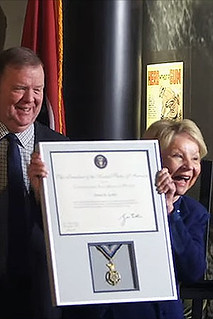 A rare medal of honor bestowed upon the fallen commander of NASA's space shuttle Challenger has been given a new space at a Tennessee museum devoted to the recipients of the United States' highest military award for valor.
A rare medal of honor bestowed upon the fallen commander of NASA's space shuttle Challenger has been given a new space at a Tennessee museum devoted to the recipients of the United States' highest military award for valor.
The family of the late astronaut Francis Richard "Dick" Scobee presented his Congressional Space Medal of Honor for display at the Charles H. Coolidge National Medal of Honor Heritage Center in Chattanooga on Tuesday (March 8). The medal was awarded posthumously in 2004 for Scobee's "meritorious and dedicated service to the nation and his pioneering contributions to human space flight."
Scobee's widow decided to give the medal a new home after coming across the heritage center on one of her daily walks around downtown Chattanooga. The museum, which was founded in 1987, moved to its current location two years ago.
"When this building came with 'Medal of Honor' in the name of it, I thought, 'Oh, there's a medal of honor hanging on the wall in my home. No one gets to see it, except when we are passing down the hallway," said June Scobee Rodgers, addressing an audience of invited guests and local school children as part of the ceremony on Tuesday. "So I thought what a nice idea if they would accept it and give it a home here in our hometown of Chattanooga."
The heritage center not only welcomed Scobee's Congressional Space Medal of Honor, but now plans a $2.5 million interactive exhibit on his life, focusing on his career as a test pilot and his role as an astronaut in America's space program.
"We at the center are grateful to the Scobees and the Rodgers family for their contribution of the Congressional Space Medal," said Frank Hughes, chairman of the Board of Trustees for the National Medal of Honor Heritage Center. "In the coming months, we will develop a new immersive exhibit on the life and career of Dick Scobee and, if you go to our website, you will have opportunity to contribute to the exhibit as we begin the campaign to add to our award winning gallery."
The Congressional Space Medal of Honor is not the same as the Medal of Honor for which the heritage center was founded and until now, has focused its displays. Authorized by Congress in 1969, the Space Medal of Honor is awarded by the President of the United States in Congress's name, based on recommendations by the NASA Administrator. It is separate from the military Medal of Honor, which is bestowed for extreme bravery and gallantry in combat.
The Congressional Space Medal of Honor can be presented to any astronaut who in the performance of his or her duties has distinguished him or herself by "exceptionalIy meritorious efforts and contributions to the welfare of the nation and of mankind." It was first awarded by President Jimmy Carter in 1978 to six Mercury, Gemini and Apollo astronauts, including Alan Shepard, the first American in space; John Glenn, the first American to orbit Earth; Gus Grissom, commander of the first Gemini mission and ill-fated Apollo 1 crew; Frank Borman, commander of the first flight to the moon; Neil Armstrong, commander of the first moon landing mission; and Charles Conrad, commander of the first crew to live on board Skylab, America's first space station.
To read the complete article, see:
Challenger astronaut's Space Medal of Honor presented for display
(http://www.collectspace.com/news/news-030822a-scobee-challenger-space-medal-honor.html)
SECRET SERVICE DOG DISTINGUISHED SERVICE MEDAL
Last week we discussed the Animals in War and Peace Medal Ceremony, which took place at the U.S. Capitol on March 9, 2022. Here's one of the winners. -Editor
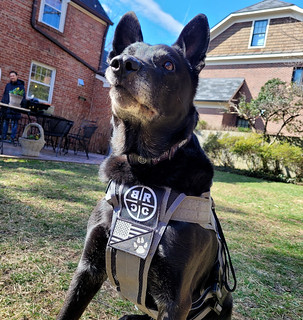 One night as the Obamas were in the White House enjoying a movie, a guy jumped the fence and tried crashing their family get-together.
One night as the Obamas were in the White House enjoying a movie, a guy jumped the fence and tried crashing their family get-together.
He never made it. He was quickly cornered by a Secret Service Belgian Malinois named Hurricane.
Hurricane met him halfway on the lawn and engaged the individual and he and him got into an intense battle," said Hurricane's handler Marshall Mirarchi.
Mirarchi was standing close by letting his partner do what he was trained to do. In the end, they arrested the man, but Hurricane did suffer some injuries. The kind that forced early retirement.
When people say the dog did his job of protecting the First Family, Mirarchi says that's not really what happened.
People say that's because he's protecting the President. I say, he doesn't know the President is back there - that's me, he's not going to let that guy get to Dad," he said.
When Hurricane retired, Mirarchi quickly adopted him, and he still keeps him active because Hurricane loves to work and keep busy.
His 15 seconds of fame didn't end that night on the White House lawn either. Now, he along with five other dogs, are getting national recognition from Congress as heroes.
Hurricane will become the very first dog in America to receive brand new recognition.
He will be the first dog to receive the Distinguished Service Medal, pretty cool,
Mirarchi said.
 The nonprofit groups Animals in War and Peace, The Livingood Group, along with U.S. War Dogs Association, helped lobby congressional lawmakers to recognize K9's who put their lives on the line to protect others.
The nonprofit groups Animals in War and Peace, The Livingood Group, along with U.S. War Dogs Association, helped lobby congressional lawmakers to recognize K9's who put their lives on the line to protect others.
While six dogs are being honored, three of them will be getting their recognition posthumously. Other Countries have for years given this kind of recognition, but for the U.S. this is new.
From a press release, here's information about two other medal recipients. -Editor
FECO, U.S. Department of Homeland Security U.S. Coast Guard, California
A member of the Canine Explosive Detection Team at Maritime Safety and Security Team San Francisco. Still serving, Feco has tirelessly conducted over 1,355 searches, including vehicles, cargo vessels and ferries, buildings, luggage, people, and mass transit facilities. Feco has spent over 2,335 hours conducting more than 584 demanding patrols around the Bay area protecting California's coastline.
MPC ZIGGY, U.S. Marine Corps Special Operations Command (MARSOC), is a multi-purpose canine. He was deployed five times to four separate countries and conducted over fifty heliborne direct action raids and assisted in discovering forty-three weapon caches, twelve homemade explosive facilities, one vehicle borne IED, 330 anti-personnel IED's, and over 5,000 pounds of homemade explosives.
To read the complete article, see:
Retired Secret Service K9 to be first dog to receive Distinguished Service Medal
(ocal12.com/news/nation-world/retired-secret-service-k9-to-be-first-dog-to-receive-distinguished-service-medal-president-white-house-hurricane-marshall-mirarchi-livingood-group-us-war-dogs-association-vienna-virgina-cincinnati-ohio)
To read the earlier E-Sylum article, see:
2022 ANIMALS IN WAR AND PEACE MEDALS
(https://www.coinbooks.org/v25/esylum_v25n09a36.html)
UNITED STATES NAVY SILVER MEDAL
I like the designs for this new Armed Forces Silver Medal for the U.S. Navy - I'll look forward to seeing one in person. -Editor
The United States Mint (Mint) will open sales for the third release in its United States Armed Forces Silver Medal Program on March 11 at noon EST. The medal honors the U.S. Navy.
Designs featured on this medal are emblematic of the history and mission of the U.S. Navy. The obverse (heads) depicts the U.S. Navy destroyer John Paul Jones cutting through the water while the U.S.S. Constitution sails behind it. An F-18 Hornet formation flies by, leaving smoke trails in the sky, paying honor to both ships. Inscriptions are UNITED STATES NAVY and DON'T GIVE UP THE SHIP, the latter spoken by mortally wounded Commander James Lawrence to his crew on the U.S.S. Chesapeake during the War of 1812. United States Mint Artistic Infusion Program (AIP) Designer Donna Weaver created the design, which was sculpted by United States Mint Medallic Artist Jay M. Kushwara.
The reverse (tails) features a line of sailors manning the rail while the American flag flies in the background. The inscriptions are the Navy's core values, HONOR, COURAGE, and COMMITMENT. AIP Designer Steve Ferris created the design, which was sculpted by United States Mint Medallic Artist John P. McGraw.
Medals in the Armed Forces Silver Medal Program weigh 2.5 ounces, are two inches in diameter, and are struck in 99.9 percent fine silver. Each medal is encapsulated and packaged in a presentation case, and is accompanied by a certificate of authenticity from the Mint.
To read the complete article, see:
United States Mint releases U.S. Navy 2.5-ounce silver medal
(https://mintnewsblog.com/united-states-mint-releases-u-s-navy-2-5-ounce-silver-medal/)
SS CENTRAL AMERICA'S PHOTOGRAPHIC TREASURE
Passing along this Guardian article about the SS Central America, Patrick Parkinson wrote, "Turns out you numismatists have it wrong. The real treasure is the daguerreotypes and ambrotypes." -Editor
Glass plate photos strewn among the gold coins and jewellery on the wreck of the SS Central America
It is one of the most famous treasure wrecks ever discovered, a steamer named the ship of gold
after it sank in 1857 off the coast of South Carolina with one of the largest cargoes of gold ever lost at sea. Miners who had struck it rich in the California gold rush were among those bringing home to New York their hard-earned wealth, only to lose their lives when the SS Central America was struck by a hurricane, sinking nearly a mile and a half beneath the waves.
When nuggets, ingots and coins were recovered from the seabed in various expeditions between 1988 and 2014, the world was dazzled. But, with reported values of tens of millions of pounds, it sparked a complex legal case that landed its original treasure-hunter in jail.
Now Dr Sean Kingsley, a British maritime archaeologist, is focusing attention on another facet of the recovered artefacts: an astonishing collection of 19th-century portraits that somehow survived at the bottom of the Atlantic.
He told the Observer: Glass plate photos had preserved the faces of miners, merchants and their families, staring up at the living from the seabed.
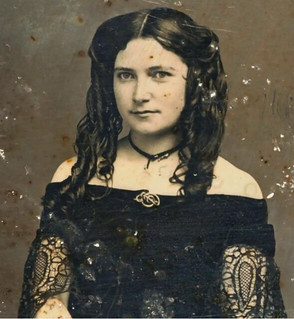 The portraits are eerie, but beautiful. These were the loved ones of those who had been on a ship that sank 150 miles from the Carolina coast with the loss of 425 lives. A judge and a comedian were among the passengers.
The portraits are eerie, but beautiful. These were the loved ones of those who had been on a ship that sank 150 miles from the Carolina coast with the loss of 425 lives. A judge and a comedian were among the passengers.
Kingsley said: There are two ships with iconic names. Titanic is known as the ‘ship of dreams'. This is known as the ‘ship of gold'. For me, the gold is a distraction. The glass plates are the true star treasures from this wreck. There's dozens more down there that I hope one day will be saved too.
When the hurricane hit, those on board dumped their bags, unable to save their prized possessions as well as their lives. As the steamer sank, the bags floated down. The leather and canvas decomposed, while gold coins and clusters of daguerreotypes and ambrotypes with dozens of individual photographs were scattered across the seabed.
Bob Evans has been researching the SS Central America since 1983 and he was the chief scientist and historian in the original field operation. He spoke of the excitement of recovering the photographs: It's over the top. They really bring forth the humanity of the event. We don't know who these people in the photographs are. These were the last things these men had with them on the deck before the ship sank – and what a moment. These were the things that were most important to them, their money and these images. They represented friends or relatives or maybe even themselves.
To read the complete article, see:
Doomed ship of gold's ghostly picture gallery is plucked from the seabed
(https://www.theguardian.com/artanddesign/2022/feb/27/doomed-ship-of-golds-ghostly-picture-gallery-is-plucked-from-the-seabed)
CABBAGE KEY
John Lupia passed along information about another Florida bar decorated with paper money. Thanks - I don't think we've covered this particular place before. -Editor
There are plenty of restaurants in Florida that offer a good waterfront view but some of them offer an interactive experience. Cabbage Key is a restaurant completely decorated with dollar bills and, you can tip in a dollar and leave your mark on this building.
There is nothing quite like this off Florida's Gulf Coast. To get here, you need to grab a ferry across the quiet waters of Pine Island Sound to Cayo Costa State Park and Cabbage Key. This place covers 100-acres of under-developed paradise. The romantic island has quiet the charm and you can view the most beautiful sunsets here.
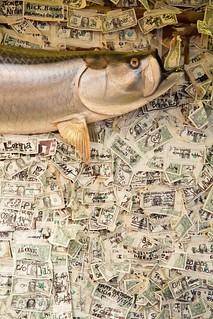 According to Manchester Evening News, the tradition of the dollar bill wall started when a thirsty fisherman left his autographed bill taped to the wall, ensuring a cold drink the next time he stopped by.
According to Manchester Evening News, the tradition of the dollar bill wall started when a thirsty fisherman left his autographed bill taped to the wall, ensuring a cold drink the next time he stopped by.
Since then, many people have left their dollar bills with personalized messages on this restaurant which now covers over $70,000 worth of George Washington wallpaper. You can look around and see all the messages people have left on the walls including public figures like Julia Roberts, Kevin Costner, and former presidents Jimmy Carter and JFK.
For more information, see:
This Hidden Restaurant In Florida Is Decorated With Thousands Of Dollar Bills
(https://www.narcity.com/cabbage-key-is-a-restaurant-completely-decorated-with-dollar-bills#toggle-gdpr)
Dining At Cabbage Key
(https://cabbagekey.com/dining/)
LOOSE CHANGE: MARCH 13, 2022
Here are some additional items in the media this week that may be of interest. -Editor
An article by Ben Wallace on the NGC site examines mints of the Byzantine Empire. -Editor
The Byzantine Empire existed for over a thousand years and controlled large tracts of land and a great many people. Many mints were needed to satisfy the monetary needs of this empire. In this article, we'll discuss those mints and enjoy some of the coins they produced.
Sicily: Syracuse
The above follis features an excellent portrait of the emperor Constans II (A.D. 641-688). Much of the detail on this coin is weak due to it being overstruck on an earlier follis. The reverse has a large M and the mintmark SCL below.
To read the complete article, see:
NGC Ancients: Mints of the Byzantine Empire
(https://www.ngccoin.com/news/article/9957/NGC-Ancients-byzantine-empire/)
Leon Saryan passed along this article from Barron's. Thanks. -Editor
Bob R. Simpson, an oilman and co-chairman of the Texas Rangers baseball team, is offering two rare gold coins from his impressive numismatic collection for sale.
A US$20 1865 Judd-452 is now available for private sale for US$5.5 million through Legend Numismatics, a New Jersey-based numismatic firm. A US$10 1863 Judd-349 gold coin will be publicly auctioned by the firm's auction arm, Legend Rare Coin Auctions, on April 28 in Schaumburg, Ill., which carries a presale estimate of US$1.25 million.
Mr. Simpson, 73, was the founder and chairman of XTO Energy, which was sold to ExxonMobil in 2009 for US$41 billion. The following year, he and another Texas oil magnate, Ray Davis, led a cohort of investors in the US$593 million purchase of the Rangers.
To read the complete article, see:
Texas Oil Billionaire Is Selling 2 Rare Gold Coins
(https://www.barrons.com/articles/texas-rangers-owner-bob-r-simpson-selling-two-rare-gold-coins-01646855019)
I came across this general article on book collecting this week, but the part that stood out to me was the name of the site - BiblioLifestyle. It's a thing, apparently. I guess we numismatic bibliophiles are just an Instagram post away from becoming Influencers. -Editor
To read the complete article, see:
Book Collecting for Beginners: Practical Tips to Get You Started
(https://bibliolifestyle.com/book-collecting-for-beginners/)
An article in Barron's examines the price of nickel. -Editor
The nickel is worth more than a dime. Nickel prices, for the metal not the coin, spiked to $100,000 per metric ton on the London Metal Exchange this past week before trading was halted. The metal had traded around $25,000 a ton before the run-up, when it cost the U.S. Mint more than five cents to make a nickel.
At $100,000 a ton, a nickel, composed of 25% nickel and 75% copper, is worth about 16 cents in metal, or melt
value, Barron's estimates. Each nickel weighs five grams—appropriately so—and contains 1.25 grams of nickel...
To read the complete article (subscription required), see:
Why the Nickel in a Nickel Is Worth More Than the Coin
(https://www.barrons.com/articles/nickel-price-51647046615)
In the Other Hobbies department, here's a piece about a Button Museum in South Carolina, including a button-covered hearse. -Editor
Talk about unusual museums that have graced the Palmetto State over the years! We'd be remiss on this subject if we didn't include a feature here on the Button Museum, which still stands in Bishopville. Its creator, Mr. Dalton Stevens, who single-handedly earned the city the title of Button Capital of the World, was a musician and an artist. Stevens passed away in November 2016, but his Button Museum and works of button art are still in place, although the facility isn't open quite as often as it was when Stevens was still alive.
To read the complete article, see:
The Button Capital Of The World Is Hiding In Small Town South Carolina And It's As Weirdly Wonderful As You'd Expect
(https://www.onlyinyourstate.com/south-carolina/button-capital-of-the-world-sc/)
MAN WOOS BRIDE WITH LUCKY LOONIES
It's not exactly wife-buying money, but Loon Dollar coins ("loonies") helped a Canadian firefighter woo an American woman he met on vacation in Mexico. Here's an excerpt from the New York Times story. See the complete article online. -Editor
But when their vacations came to a close, reality set in. Ms. Dopp was returning to Buffalo, where she was between jobs at the time, and Mr. MacDonald to Calgary, Alberta, where he lived and worked as a firefighter with the Rocky View County Fire Department.
As they exchanged tearful goodbyes in Mexico, I didn't know if I was ever going to see her again,
said Mr. MacDonald, who handed her a Canadian one-dollar coin called a loonie.
The coins had become a symbol of good luck in his country ever since the 2002 Winter Olympics in Salt Lake City, when a Canadian worker placed one under the ice of the Olympic hockey rink ahead of the games, and both the Canadian women's and men's hockey teams later won gold medals.
When he gave the loonie to Ms. Dopp, I was hoping for the same gold medal luck,
Mr. MacDonald said.
On every visit, Ms. Dopp also received a new loonie from Mr. MacDonald.
In late December 2019, the couple went to New York City to celebrate New Year's Eve with some friends. On the morning of Dec. 28, they were ice skating at Rockefeller Center when Mr. MacDonald surprised Ms. Dopp by proposing on the rink. As people around them began clapping and taking photos, their friends, whom he had tipped off ahead of time, showed up to join in the celebration.
All those lucky loonies I was giving her paid off,
Mr. MacDonald said of Ms. Dopp accepting his proposal.
On Jan. 21, they were married at the office of the city clerk in Tonawanda, N.Y., and on Jan. 28, they held a second wedding celebration at Pueblo Bonito Sunset Beach Golf & Spa resort in Cabo San Lucas.
To read the complete article, see:
Those Lucky Coins Paid Off
(https://www.nytimes.com/2022/03/11/style/kelly-macdonald-ashleigh-dopp-wedding.html)
To read an earlier E-Sylum article, see:
LOONIE DESIGNER ROBERT-RALPH CARMICHAEL, 1937 - 2016
(https://www.coinbooks.org/esylum_v19n30a13.html)
VISITING THE STRANGEST "LIBRARY" EVER
Finally, for the bibliophiles, here's the coolest final resting place ever. Maybe you can't take your books with you, but you can become one... -Editor
East Lawn is a pretty park in the beautiful surroundings of old East Sacramento, with mature trees and an inviting air, perfect for anyone, except for one thing: It's a park for the dead.
East Lawn is a cemetery.
Decades later, I found out East Lawn contained a surprise the casual passerby could never have anticipated.
In 2017, I actually had a reason to stop by and go inside the forbidding main building, constructed a century ago. I was just looking for help finding a relative's grave. Not that I still felt like I had to justify walking in the door. I assumed it was all offices, or something.
When I remarked approvingly to the receptionist about the stained glass windows on the landing, I was pleasantly surprised to be invited to pop upstairs to have a look around. In fact, contrary to what I assumed, the building (except the office, naturally) is all open to the well-behaved public. And even more amazingly, what I found upstairs was the world's oddest library.
This, folks, is a library for the dead.
Or, more accurately, it's a library OF the dead.
I mean, why be content with a plain old gravestone stuck out in the rain or in the blazing Sacramento summer heat? Why, indeed, when you can spend eternity buried in a book. Literally. Where your loved ones can sit in air-conditioned comfort and style, contemplating the literary wonder that once was you.
In case I haven't spelled it out, every book
is in fact an urn, containing the cremated remains of a Sacramentan.
I found it hard not to be charmed here. That's because, for what I assume is a substantial extra charge, you (or your family) get to personalize an alcove around your book
, and that's what makes this library
actually pretty endearing.
The more I looked around, the more I warmed to this unlikely library. I daresay that if there's room left, East Lawn's staff will be happy to chat with any interested librarians or other booklovers considering a tenancy on the shelves.
So how cool is THAT? -Editor
To read the complete article (subscription required), see:
A Library Full of People
(https://annettelaing.substack.com/p/a-library-full-of-people)
FEATURED WEB PAGE: CHRONOGRAMS ON COINS
This week's Featured Web Page is about Chronograms on coins. From the coingallery.de site.
Chronogram is a phrase of which the roman-numeral letters (C,D,I,L,M,V,X) express a date when added together. (e.g. LorD haVe MerCIe Vpon Vs = 50+500+5+1000+100+1+5+5=1666). The order was irrelevant, the sequence IV stood for 1+5=6 and not for 4. On coins, the numerals are indicated in exaggerated capital Roman letters within the legend. Chronograms were particularly popular in the Baroque Age although counting the numerals was tiresomeone and one had to struggle through obscure statements in scholars' Latin.
https://www.coingallery.de/Varia/_varia_2_E.htm

